Birds in the rainforest are some of the most fascinating creatures that inhabit our planet. The rainforest ecosystem is a vast and complex system that is home to a plethora of bird species.
These birds are not only unique in their vibrant colors and beautiful songs but also play crucial roles in maintaining the ecological balance of the rainforest.
Rainforest birds have adapted to a variety of niches to ensure that they can survive and thrive in such a dense and challenging environment.
From ground-dwelling birds to canopy dwellers, the rainforest has it all.
In this article, we will explore the fascinating world of birds in the rainforest and get more in-depth knowledge of some of the most unique rainforest birds.
1. Hummingbirds
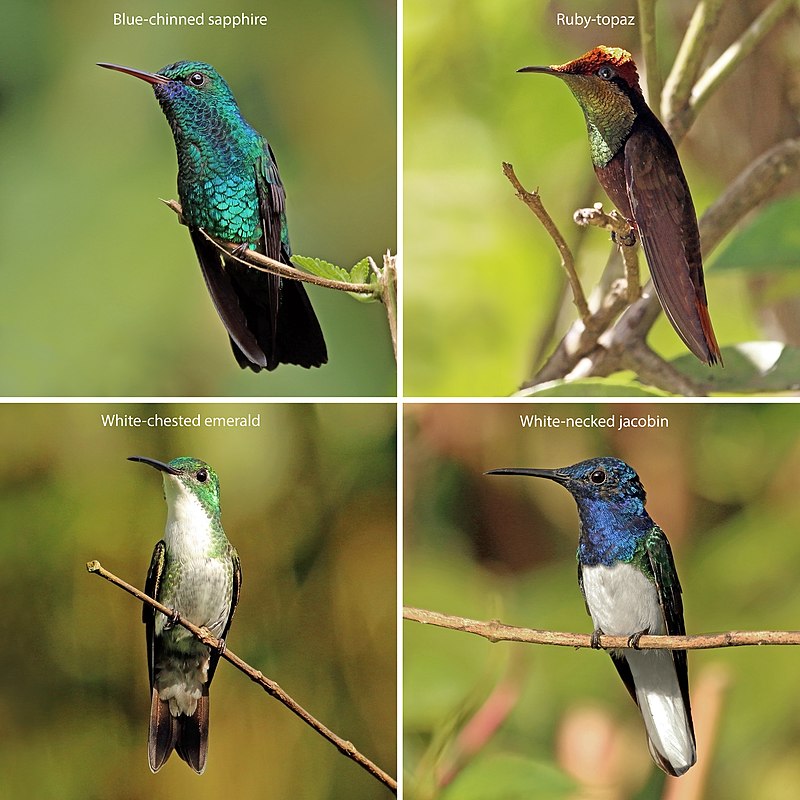
Hummingbirds are tiny birds found throughout the Americas, from Alaska to Tierra del Fuego. Most species measure between 3-5 inches in length and weigh less than an ounce.
The smallest hummingbird is only 2 inches long. Hummingbirds have a unique ability of hovering by rapidly flapping their wings up to 80 times per second.
They feed on nectar and insects, with some species even able to drink sap or eat pollen directly off flowers.
Their vibrant colors make them instantly recognizable as they dart through gardens in search of food and mates.
Hummingbirds truly bring joy into our lives as they remind us that nature’s beauty can be seen around every corner if we take the time to look for it.Scientific classification:
| Kingdom | Animalia |
| Phylum | Chordata |
| Class | Aves |
| Order | Apodiformes |
| Family | Trochilidae Vigors, 1825 |
Also Featured In: Most Common United States Birds, Birds for Your Home Garden
2. Toco Toucan
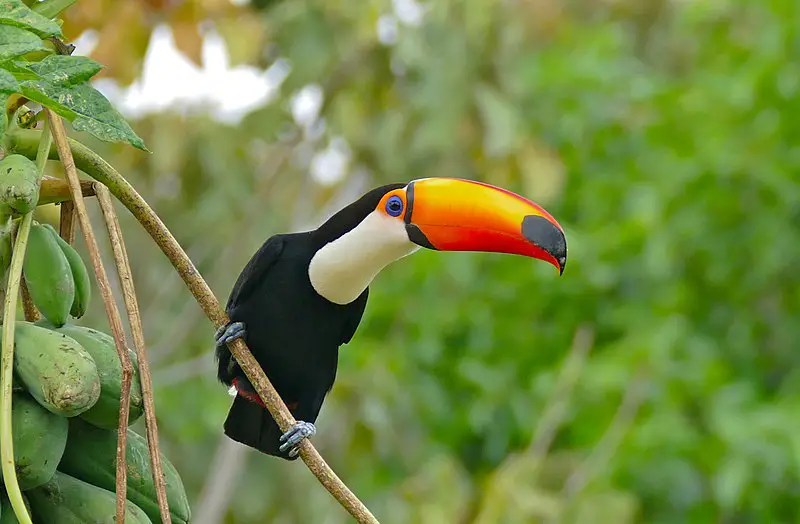
The Toco Toucan is the largest and most recognizable species of toucans, native to semi-open habitats in Central and Eastern South America.
First described by German zoologist Philipp Ludwig Statius Müller in 1776, this colorful bird has two subspecies – Ramphastos toco toco and Ramphastos toco cuvieri – distinguished by their slightly different size, plumage coloration, beak markings and range.
With its large orange bill covered with black spots along the sides of its face contrasting with yellow feathers on top of its head , it’s a very striking animal indeed.
Commonly found in zoos around the world too due tot heir loveable nature they are often kept as pets. They feed mainly on fruit but may also eat insects or small reptiles from time to time.
All in all these birds provide us a wonderful spectacle that we should appreciate for many years ahead.Scientific classification:
| Kingdom | Animalia |
| Phylum | Chordata |
| Class | Aves |
| Order | Piciformes |
| Family | Ramphastidae |
| Genus | Ramphastos |
| Species | R. toco |
Also Featured In: Beautiful Brazilian Birds, Most Common Birds in South America Birds
3. Toucans
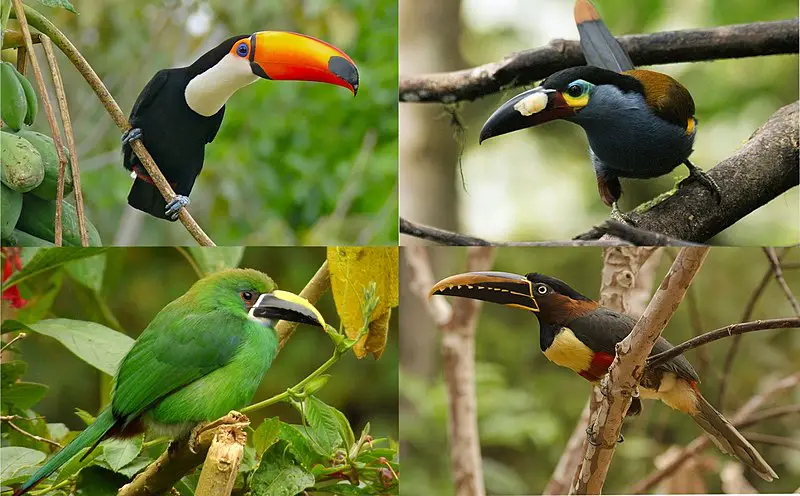
Toucans are members of the Ramphastidae family, which is closely related to American barbets. These birds have brightly-colored feathers and large beaks that come in a variety of colors.
They tend to live high up in trees, where they make their nests with two or four white eggs inside.
Toucans typically feed on fruits and sometimes small insects as well. Some species can even catch larger animals such as reptiles and amphibians for food.
Although toucans like to keep close together when living in groups, during breeding season they become more aggressive towards each other due to competition over resources like nesting sites or food sources.Scientific classification:
| Kingdom | Animalia |
| Phylum | Chordata |
| Class | Aves |
| Order | Piciformes |
| Infraorder | Ramphastides |
| Family | Ramphastidae Vigors, 1825 |
Also Featured In: Famous Paintings Birds,
4. Hyacinth Macaw
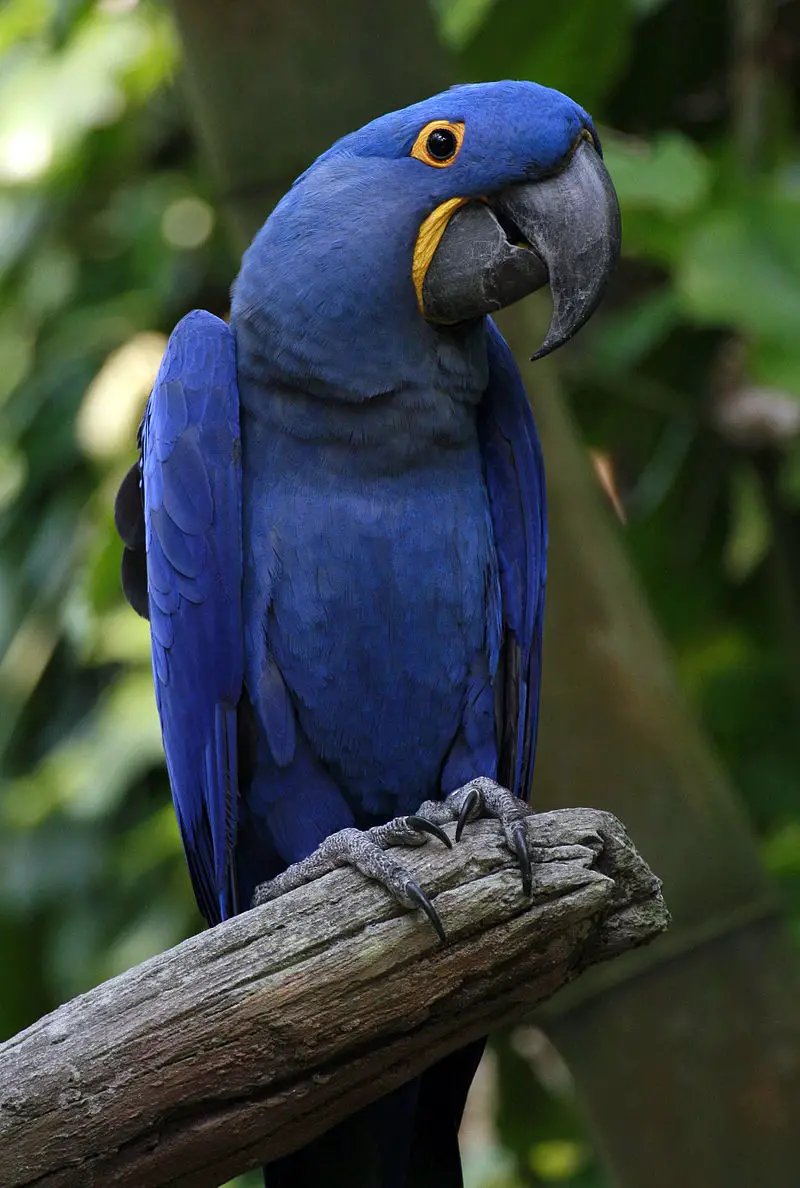
The Hyacinth Macaw is an extraordinary bird, known for its impressive size and vibrant coloration.
It has a length of around one meter, making it the longest parrot species in existence as well as the largest flying parrot species; even larger than 3.5 kg flightless Kākāpō from New Zealand.
Its striking blue plumage with yellow at its wingtips gives this majestic bird an eye-catching appearance that’s sure to turn heads wherever it goes.
Native to central and eastern South America, these birds are highly intelligent creatures who form strong bonds with their owners when kept in captivity.
They make great companions if given proper care and attention which includes providing them with plenty of space for exercise and enrichment activities such as playtime out of the cage on occasion or teaching them tricks using positive reinforcement methods like verbal praise or food rewards.Scientific classification:
| Kingdom | Animalia |
| Phylum | Chordata |
| Class | Aves |
| Order | Psittaciformes |
| Family | Psittacidae |
| Genus | Anodorhynchus |
| Species | A. hyacinthinus |
Also Featured In: Blue Birds You’ll Found around Us, Common Latin America Birds
5. Scarlet Macaw
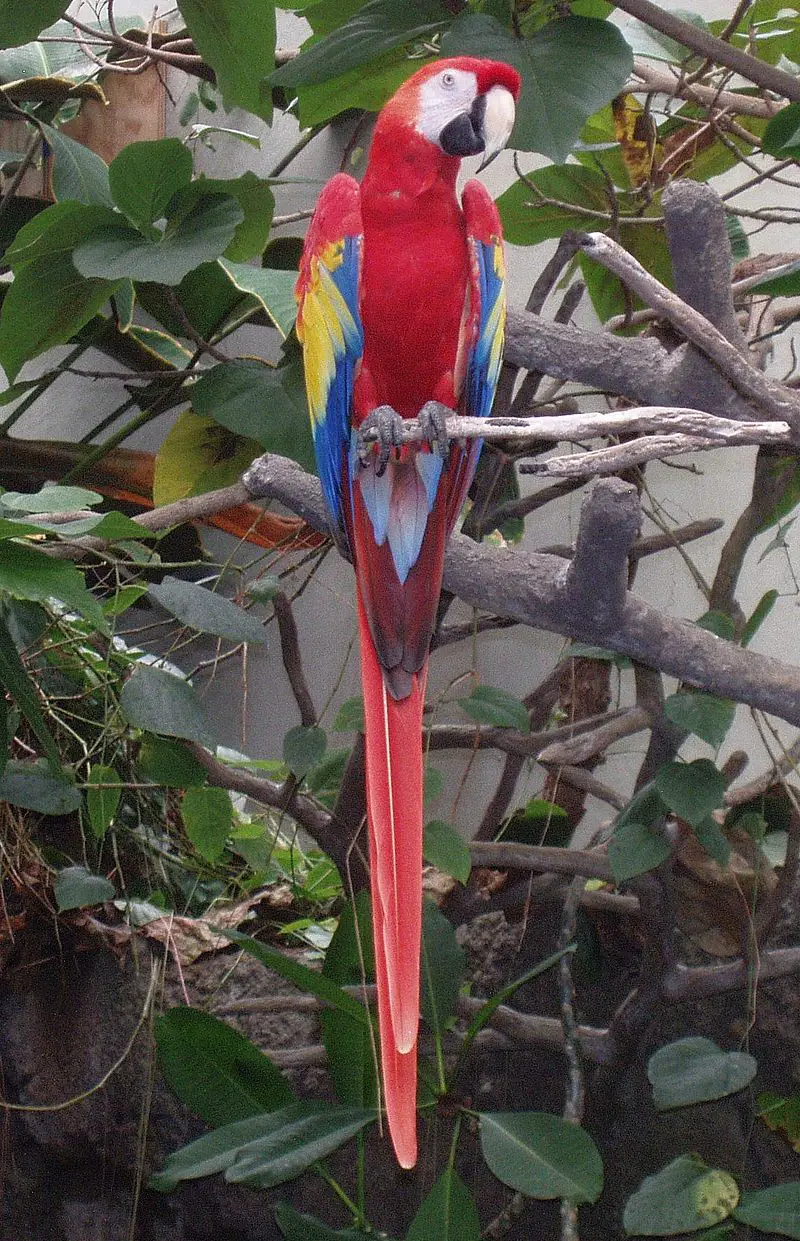
The Scarlet Macaw is a vibrant and beautiful bird found in Central and South America. Its striking red, yellow, and blue feathers make it stand out among other parrots.
It inhabits humid evergreen forests of the Neotropics from Mexico to Peru, Ecuador, Colombia, Bolivia Venezuela Brazil up to an altitude of 1000m (3300ft).
These birds have strong beaks which they use for breaking open hard nuts or seeds that would otherwise remain inaccessible.
They also form social bonds with their mates by grooming eachothers’ feathers and engaging in playful activities such as chasing one another around tree trunks.
Despite its vivid colors the Scarlet Macaw remains vulnerable due to habitat loss caused by deforestation so conservation efforts are essential if this amazing species is going to survive for future generations.Scientific classification:
| Kingdom | Animalia |
| Phylum | Chordata |
| Class | Aves |
| Order | Psittaciformes |
| Family | Psittacidae |
| Genus | Ara |
| Species | A. macao |
Also Featured In: Spiritual Birds, Case Birds that Live in with Us
6. Wattled Jacana
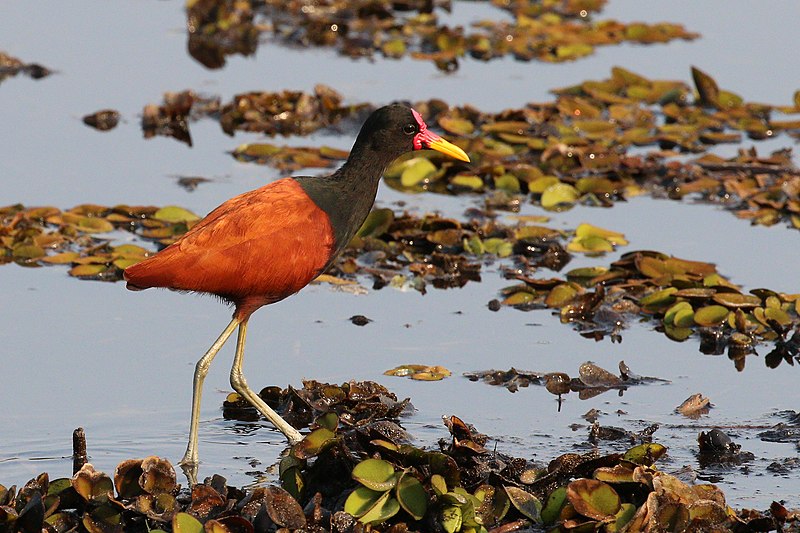
The Wattled Jacana is a stunning bird from central and south America. It has long legs, a black head with yellow wattles at each side, and striking chestnut brown wings.
This wader builds its nest on the surface of ponds or lakes using floating vegetation such as lily pads to anchor it in place – usually with four eggs that are darkly marked.
The male takes primary responsibility for incubation of these eggs between his wings, while the female will take care of her chicks once they hatch out.
These birds feed mainly on aquatic insects but also small fish and amphibians if available.
Overall this species is an interesting and attractive addition to any wetland habitat.Scientific classification:
| Kingdom | Animalia |
| Phylum | Chordata |
| Class | Aves |
| Order | Charadriiformes |
| Family | Jacanidae |
| Genus | Jacana |
| Species | J. jacana |
7. Hoatzin
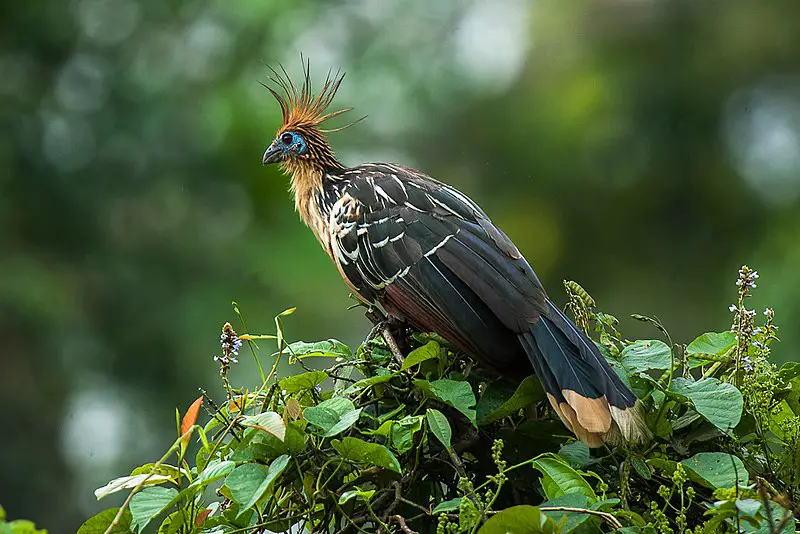
The Hoatzin bird is a tropical species found in the Amazon and Orinoco river basins of South America. It inhabits swamps, riparian forests and mangroves.
This unique bird has chicks that have claws on two of their wing digits which make it the only member in its order – Opisthocomiformes.
Its most distinctive feature is an odour produced from its digestive system which smells like cow manure.
The adults are brownish-grey with blue facial skin, red eyes, pointed crest feathers and black primaries.
They feed mainly on leaves but also eat flowers, fruits or buds when available during different seasons.
They can be heard making loud calls resembling caws at night time as well as repeated whistles throughout the day to keep contact between family members within flocks.Scientific classification:
| Kingdom | Animalia |
| Phylum | Chordata |
| Class | Aves |
| Order | Opisthocomiformes |
| Family | Opisthocomidae |
| Genus | Opisthocomus Illiger, 1811 |
| Species | O. hoazin |
Also Featured In: Birds that Live in Guyana,
8. Neotropic Cormorant
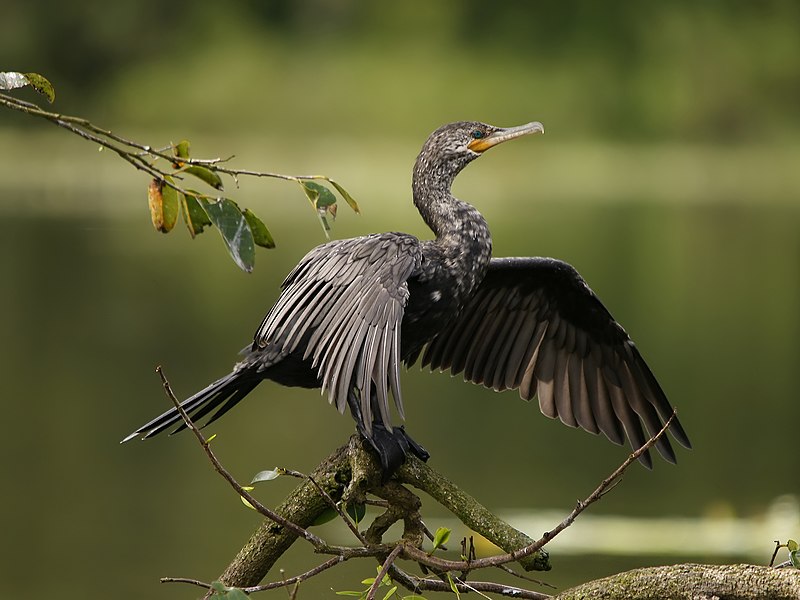
The Neotropic Cormorant, also known as the Olivaceous Cormorant, is a medium-sized bird found in tropical and subtropical regions of Central America, South America and the United States.
It can be identified by its black body with bright yellow facial skin on both sides of its large bill. The tail feathers are short and squared off at the tip.
This species breeds mainly on coasts but will sometimes nest inland near rivers or lakes during certain parts of their life cycle.
They feed mostly on small fish caught while diving underwater but can also eat crustaceans, amphibians and insects.
These birds roost in trees at night to keep safe from predators like foxes which prey upon them when they sleep close to water sources during daylight hours.Scientific classification:
| Kingdom | Animalia |
| Phylum | Chordata |
| Class | Aves |
| Order | Suliformes |
| Family | Phalacrocoracidae |
| Genus | Nannopterum |
| Species | N. brasilianum |
Also Featured In: Puerto Vallarta Birds You Should Know, Common Birds of Houston
9. Amazon Kingfisher
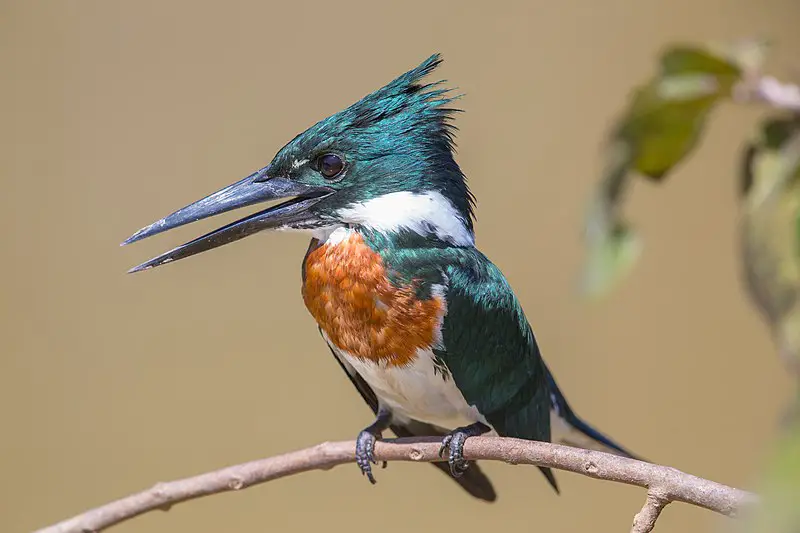
The Amazon Kingfisher is a stunning species of water kingfisher found in the lowlands of Central and South America.
It has an aqua-green head, chestnut wings with white markings, blue back and tail and yellow feet.
Its dramatic plumage makes it one of the most attractive birds in its region.
The Amazon Kingfisher can be seen perching on branches or flying close to slow moving rivers while they search for food such as fish, frogs, lizards or insects which they catch by diving into the water from above.
Despite their colorful appearance these bird are incredibly shy so it’s difficult to get too close without scaring them away.Scientific classification:
| Kingdom | Animalia |
| Phylum | Chordata |
| Class | Aves |
| Order | Coraciiformes |
| Family | Alcedinidae |
| Subfamily | Cerylinae |
| Genus | Chloroceryle |
| Species | C. amazona |
Also Featured In: Most Common Oaxaca Birds, Birds that Live in Tabasco
10. Blue-And-Yellow Macaw
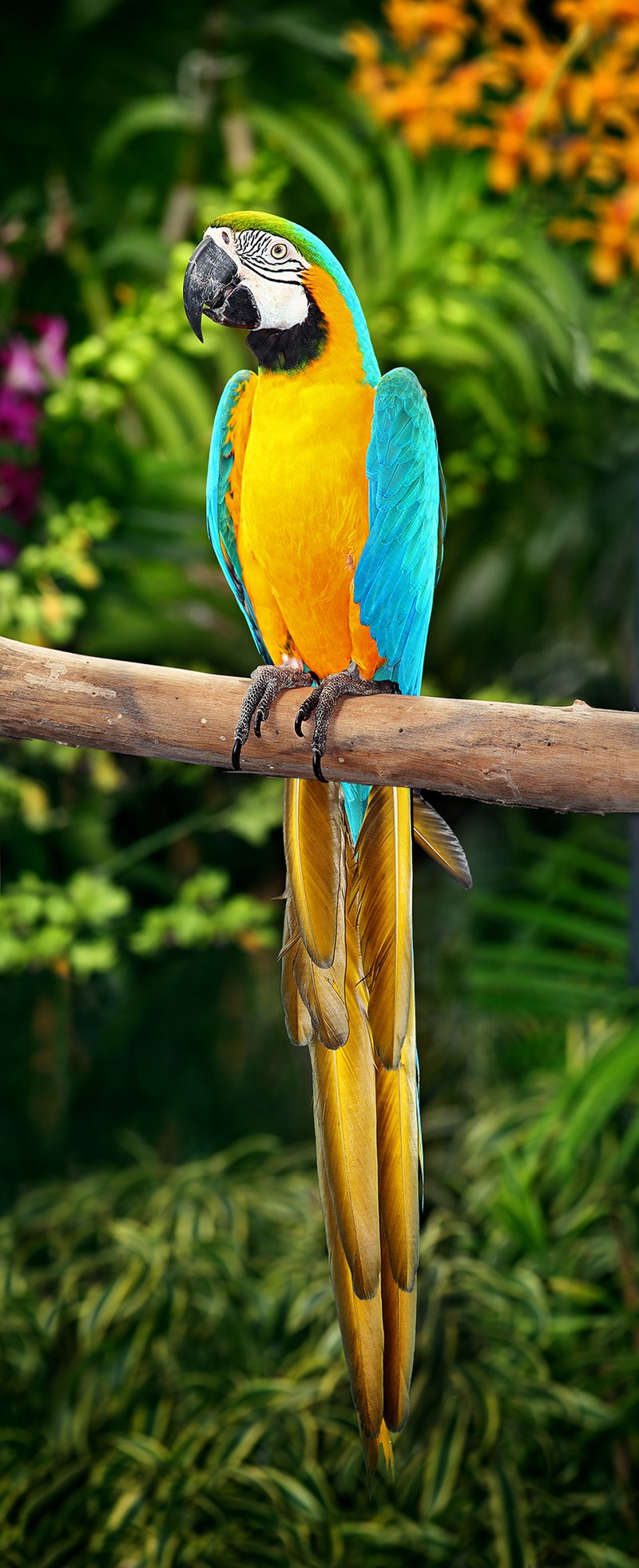
The Blue-and-yellow Macaw is a vibrant and eye catching bird native to South America. It has beautiful blue top parts, light orange underparts, and green on its head.
This large parrot lives in the tropical forests of varzea, terra firme or unflooded forest areas.
They are social birds that live in small flocks which can range from two to twenty birds during breeding season when they look for mates.
They feed mainly on seeds, nuts and fruits but sometimes also eat insects like beetles and caterpillars as well as tender shoots from trees & plants.
These macaws have an impressive call with loud screams used both to attract mates and communicate between members of their flock while flying long distances across open fields together.Scientific classification:
| Kingdom | Animalia |
| Phylum | Chordata |
| Class | Aves |
| Order | Psittaciformes |
| Family | Psittacidae |
| Genus | Ara |
| Species | A. ararauna |
Also Featured In: Pet Birds that Live in India,
11. Trogon
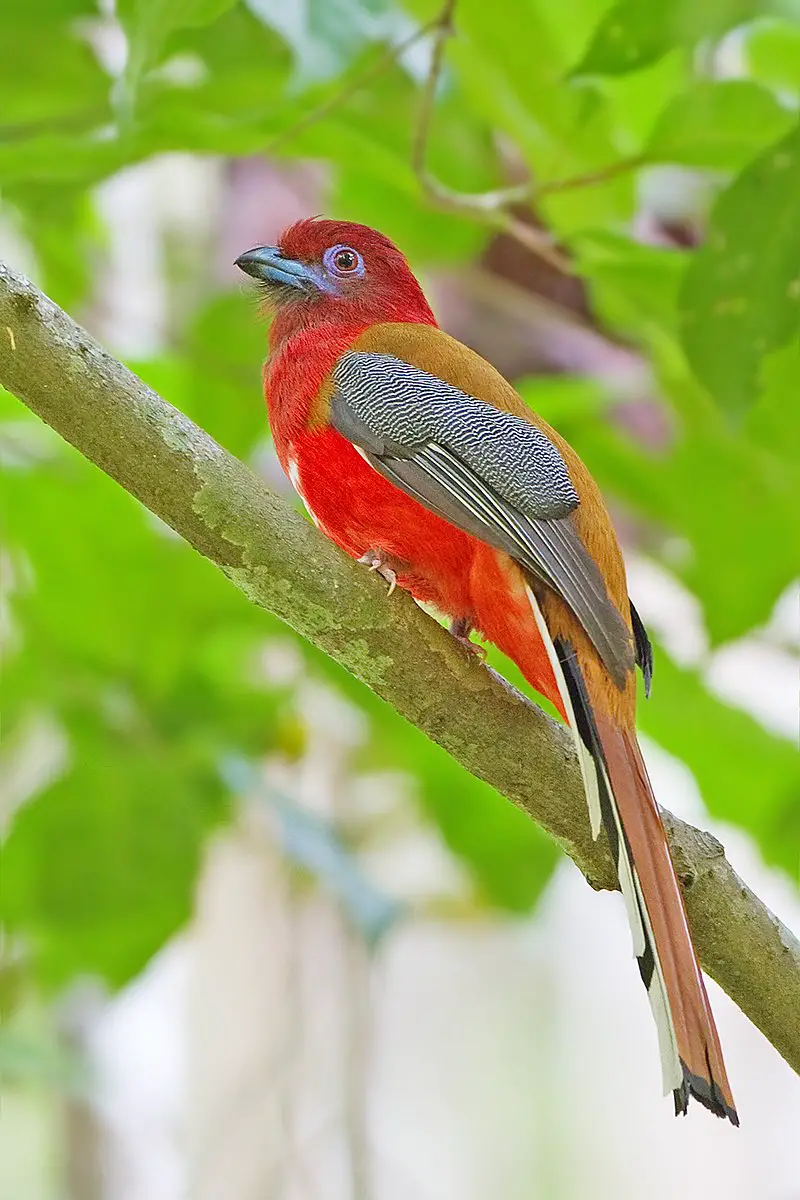
Trogons are a unique bird species that can be found all over the world. They belong to the order Trogoniformes and have only one family, called Trogonidae, which consists of 46 species in seven genera.
Fossil records show that trogons existed 49 million years ago during the Early Eocene period. It is believed they may be closely related or form part of two other orders: Coraciiformes and Passerines.
These birds typically have brightly colored feathers with some having iridescent colors on their wings and tails as well as red bellies and breasts.
Their diet mainly consists of fruit, insects, lizards and frogs but larger ones will also feed on small mammals such as mice or bats.
The most famous member from this group is Quetzalcoatlus – an extinct giant pterosaur which lived approximately 70-65 million years agoScientific classification:
| Kingdom | Animalia |
| Phylum | Chordata |
| Class | Aves |
| Clade | Cavitaves |
| Clade | Eucavitaves |
| Order | Trogoniformes AOU, 1886 |
| Family | Trogonidae Lesson, 1828 |
Also Featured In: Birds of the Philippines, Birds that Live in Borneo Island
12. Hornbill
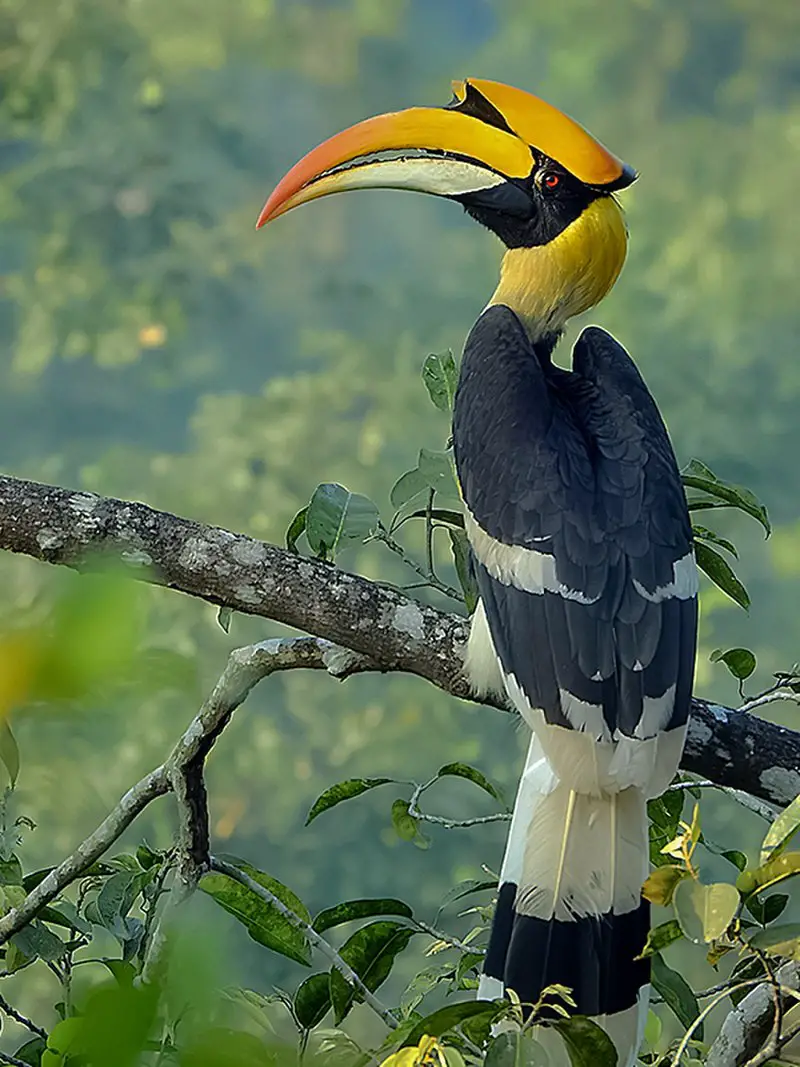
Hornbills are a tropical and subtropical bird species with characteristic long, curved bills. Their English and scientific names both refer to the shape of their bill which resembles that of a cow’s horn.
They have strong beaks for cracking open hard-shelled fruits as well as powerful wings for flying between trees or over great distances in search of food or mates.
Hornbills also feature beautiful plumage ranging from white to black feathers with yellow, brown, red and blue accents on the head, neck and back areas depending on the species.
In addition they often display brightly coloured casques – helmet like structures – atop their upper mandible adding further visual appeal to these majestic birds.Scientific classification:
| Kingdom | Animalia |
| Phylum | Chordata |
| Class | Aves |
| Order | Bucerotiformes |
| Family | Bucerotidae Rafinesque, 1815 |
Also Featured In: Birds of South African, African Birds
13. Andean Cock-Of-The-Rock
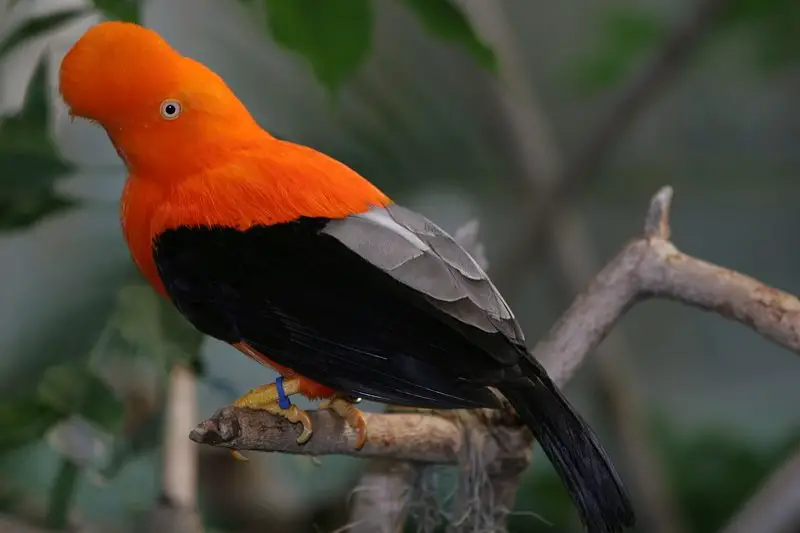
The Andean cock-of-the-rock is a large passerine bird belonging to the Cotinga family. It has four subspecies and can be found in the cloud forests of South America, notably Peru where it has been declared its national bird.
This species exhibits marked sexual dimorphism; males have an impressive orange crest that covers most of their head as well as a bright coral chest patch while females are mainly grey with dark wings and tail feathers.
Both sexes also feature black heads, yellow eyes, long bills and short legs.
Their diet consists mostly of fruits but they have also been known to eat small insects for protein.
They are monogamous birds who mate for life forming strong pair bonds that last several years until one partner dies or moves away from its territory.Scientific classification:
| Kingdom | Animalia |
| Phylum | Chordata |
| Class | Aves |
| Order | Passeriformes |
| Family | Cotingidae |
| Genus | Rupicola |
| Species | R. peruvianus |
Also Featured In: Common Birds in Colombia,
14. Keel-Billed Toucan
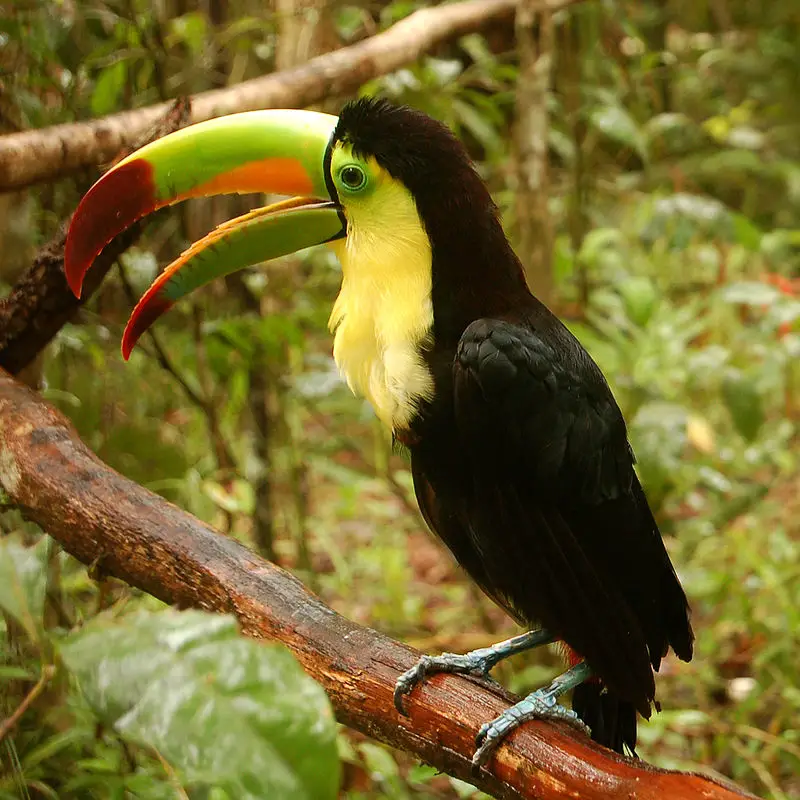
The Keel-billed Toucan is a vibrant Latin American bird from the toucan family and also serves as Belize’s national bird. They are found in tropical jungles stretching all the way from southern Mexico to Colombia.
They feed on fruits, seeds, insects, lizards and snakes – being omnivorous birds they eat pretty much anything.
These colourful creatures have an impressive beak with green upper parts of their bodies coupled with yellow lower halves.
The underside of their tail feathers are black while its tips remain white creating for quite a stunning display when flying or perched atop tree branches.Scientific classification:
| Kingdom | Animalia |
| Phylum | Chordata |
| Class | Aves |
| Order | Piciformes |
| Family | Ramphastidae |
| Genus | Ramphastos |
| Species | R. sulfuratus |
15. Blue-Gray Tanager
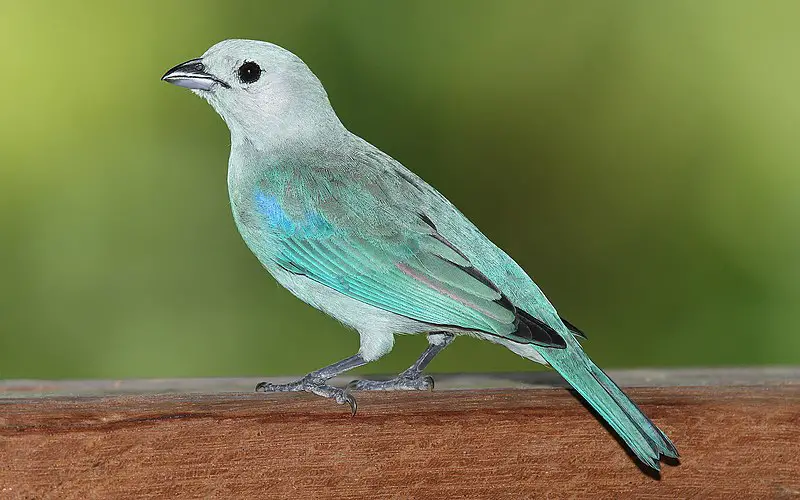
The blue-gray tanager is a medium-sized songbird native to South America, ranging from Mexico all the way down to northern Brazil and Bolivia.
It has been introduced in Lima, Peru as well as Trinidad and Tobago where it is called “blue jean”.
This species was first described by French zoologist Mathurin Jacques Brisson in 1760. The bird’s plumage features hues of gray, blue, yellow and green creating an attractive contrast against its white belly.
Its diet consists mainly of insects like beetles but also fruits such as figs are known to be part of their daily nutrition.
Blue-gray tanagers usually inhabit humid forests near running watercourses making them relatively easy to spot while they search for food on tree branches or foliage cover around streams during the day time.Scientific classification:
| Kingdom | Animalia |
| Phylum | Chordata |
| Class | Aves |
| Order | Passeriformes |
| Family | Thraupidae |
| Genus | Thraupis |
| Species | T. episcopus |
16. King Vulture
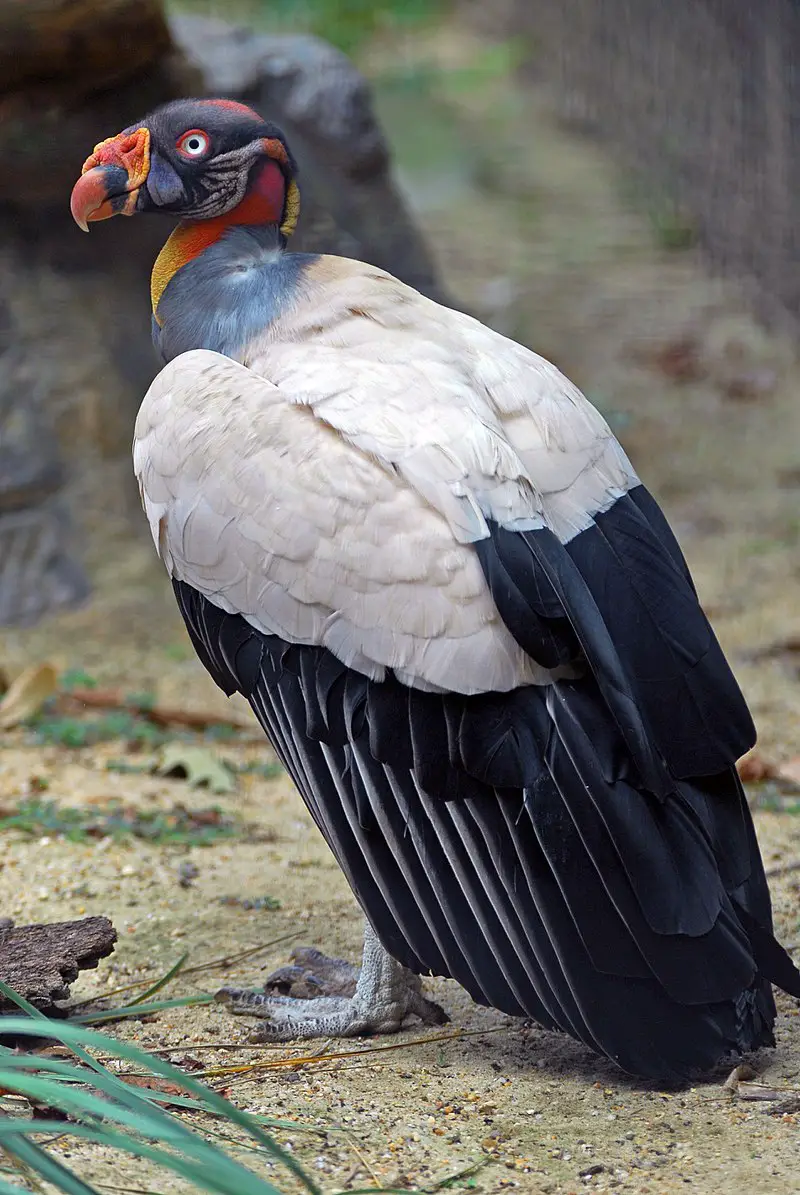
The King Vulture is a majestic bird found in Central and South America. It has striking white plumage with black accents, and its head is topped by a bright yellow crest.
With long wingspan of up to 4 feet, this vulture soars gracefully through the sky. Its large size allows it to dominate other scavenging birds at carcasses; although not as powerful as some raptors, the king vulture will protect what belongs to it fiercely.
The diet of these elegant creatures consists mainly of carrion such as dead mammals or fish that they spot from far away using their excellent vision.
They also occasionally eat eggs or nestlings if food is scarce during dry seasons.
This fascinating species plays an important role in keeping ecosystems healthy by removing dead animals from landscapes quickly before diseases spread further into populationsScientific classification:
| Kingdom | Animalia |
| Phylum | Chordata |
| Class | Aves |
| Order | Accipitriformes |
| Family | Cathartidae |
| Genus | Sarcoramphus |
| Species | S. papa |
Also Featured In: Scavengers Birds You Should Know, Common Carnivore Birds
17. Harpy Eagle
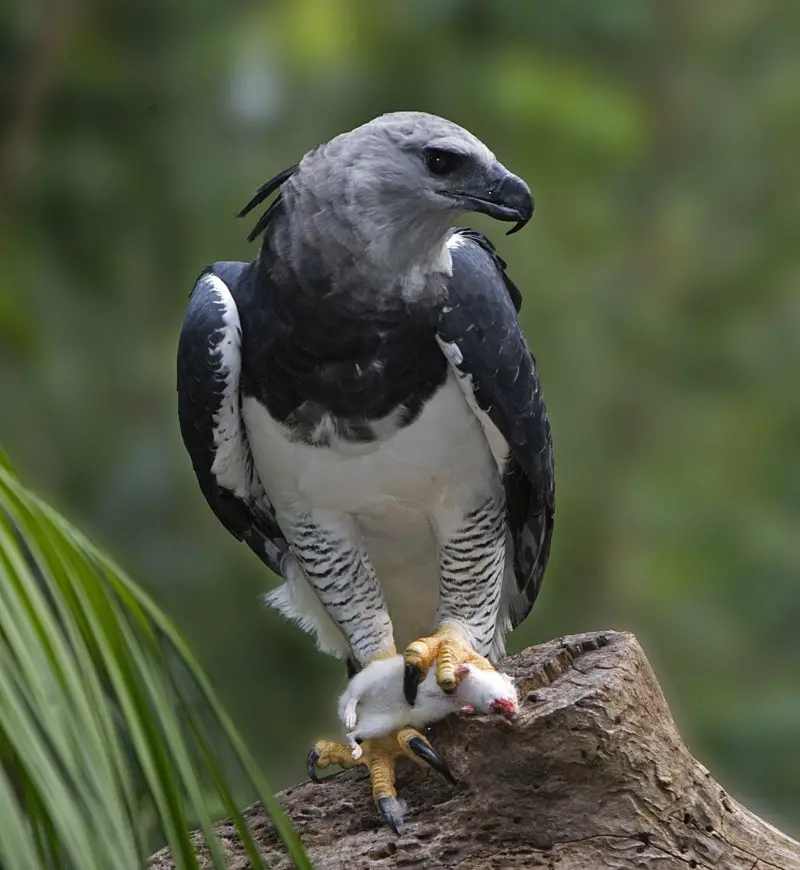
The Harpy Eagle is a magnificent bird of prey found in the tropical forests of Central and South America. It is the largest eagle on Earth, possessing an impressive wingspan that can reach up to 7 feet across.
Its powerful talons are its most distinguishing feature, being able to grasp even large animals such as monkeys or sloths with ease.
The majestic raptor has slate-gray feathers on its back and head which contrast against white undersides and yellow legs.
These birds live alone for much of their life but will come together during breeding season when they construct elaborate nests high off the ground in tall trees.
People have long been fascinated by this species’ impressive size and strength—it truly deserves its nickname as “the lord of skies”.Scientific classification:
| Kingdom | Animalia |
| Phylum | Chordata |
| Class | Aves |
| Order | Accipitriformes |
| Family | Accipitridae |
| Subfamily | Harpiinae |
| Genus | Harpia Vieillot, 1816 |
| Species | H. harpyja |
18. Festive Amazon
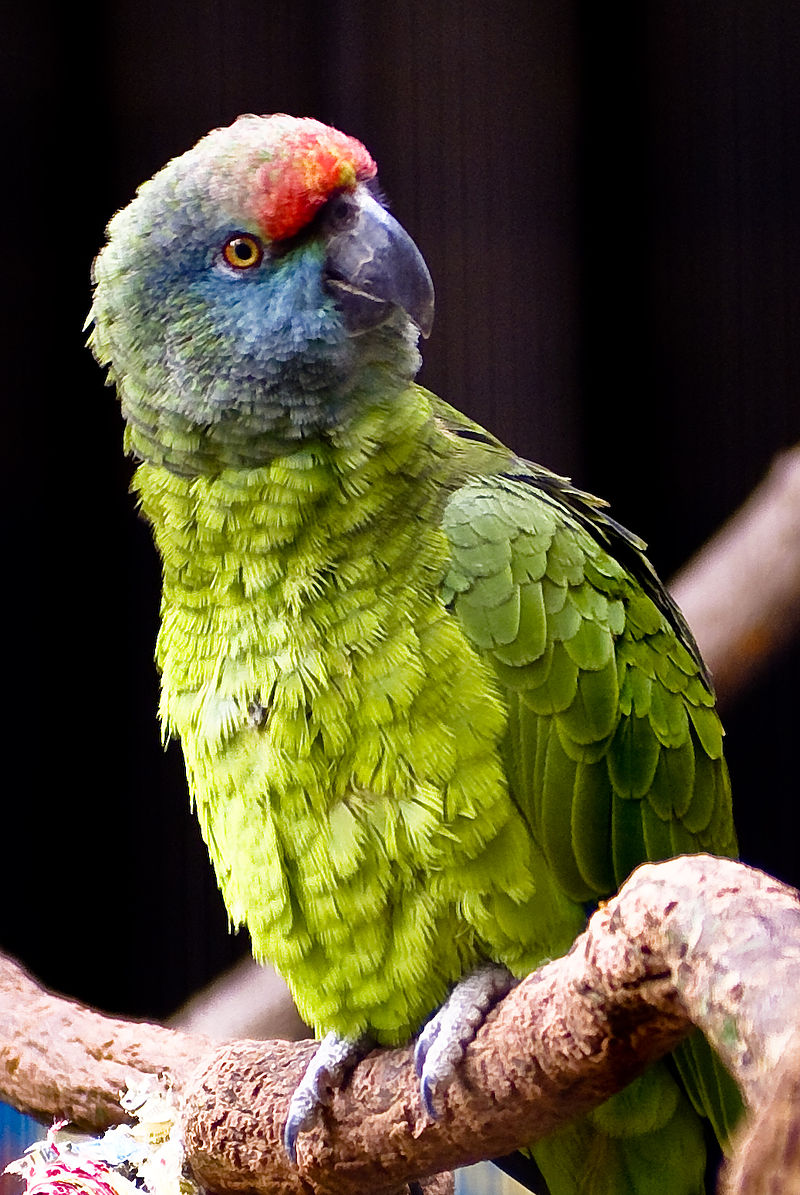
The Festive Amazon is a vibrant parrot species located in Brazil, Colombia, Ecuador, Bolivia, Guyana and Venezuela. It inhabits tropical forests near the major rivers of these countries as well as coastal mangroves in Amapá.
This beautiful bird has two subspecies – A. f festiva and A.f amazonica that differ slightly from each other in their physical characteristics such as size and plumage colouration.
The festive amazon measures between 33-35 cm long with its wingspan reaching up to 45cm , making it one of the largest parrots found in South America.
Its signature bright green feathers are complemented by yellow patches on its chest area creating an eye-catching display; truly living up to its name ‘Festive’ .Scientific classification:
| Kingdom | Animalia |
| Phylum | Chordata |
| Class | Aves |
| Order | Psittaciformes |
| Family | Psittacidae |
| Genus | Amazona |
| Species | A. festiva |
Also Featured In: Most Unique Birds in Peru,
19. Striated Heron
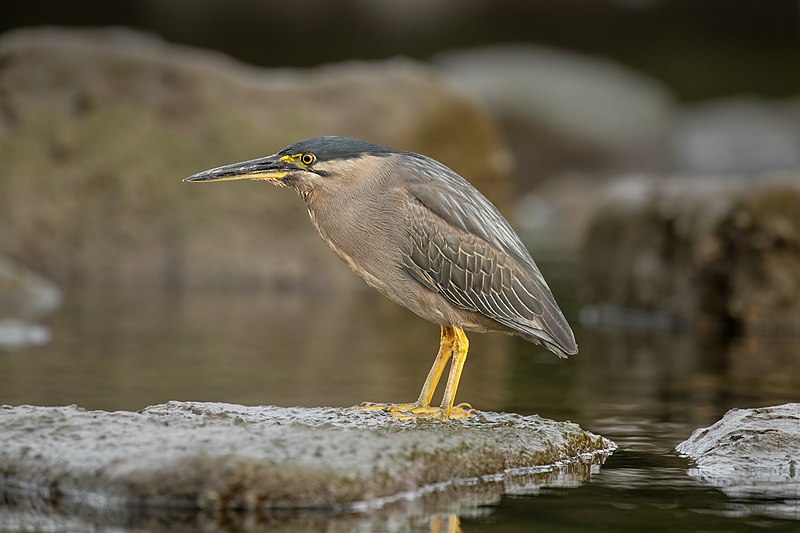
Striated herons are a small species of heron, measuring around 44cm tall. They can be found in wetland areas across the Old World tropics, from west Africa to Japan and Australia as well as South America and the Caribbean.
Striated herons have some interesting behavioral traits that make them unique; they’re mostly sedentary birds who tend to stay close to their breeding habitats throughout most of the year.
During breeding season these little green-backed herons become more active, often performing courtship dances in order to attract mates before nesting together on nearby trees or shrubs.Scientific classification:
| Kingdom | Animalia |
| Phylum | Chordata |
| Class | Aves |
| Order | Pelecaniformes |
| Family | Ardeidae |
| Genus | Butorides |
| Species | B. striata |
Also Featured In: Beautiful Malaysian birds, Asian Birds
20. Parrots
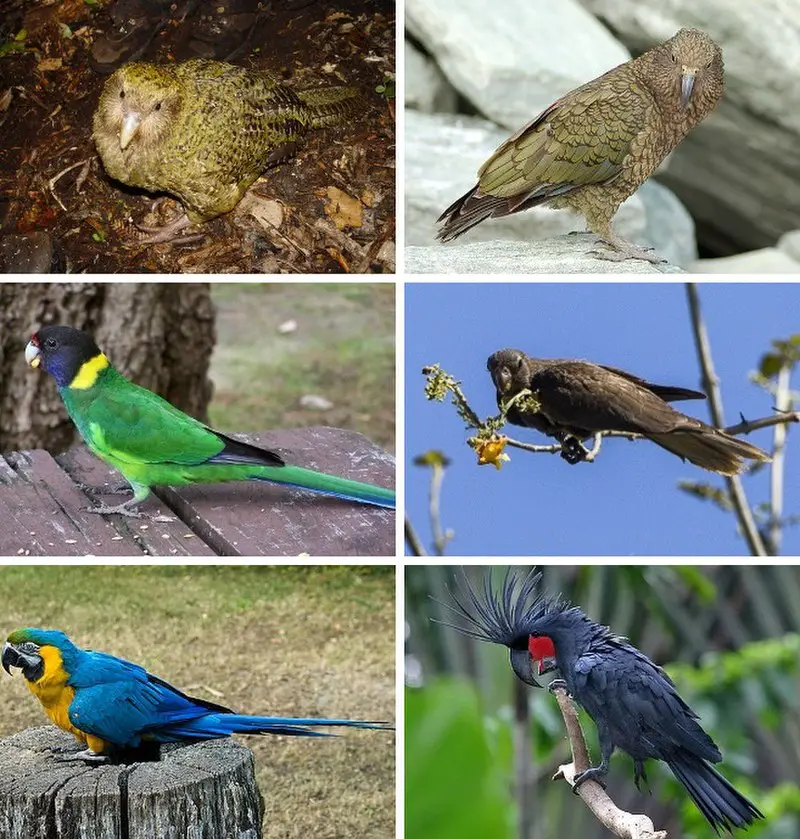
Parrots are a diverse group of birds, found in tropical and subtropical regions. They make up the order Psittaciformes, which is divided into three superfamilies: “true” parrots (Psittacoidea), cockatoos (Cacatuoidea) and New Zealand Parrots (Strigopoidea).
Many species have brightly colored feathers that can be red, yellow or blue. Their strong curved bills allow them to feed on fruits, nuts and seeds.
Parrot behavior ranges from playful to aggressive depending on their environment and socialization with humans.
Some even learn human words. As beloved pets they bring joy to many households around the world though it’s important for owners to understand how best to care for these intelligent creatures so as not to cause distress or harm.Scientific classification:
| Kingdom | Animalia |
| Phylum | Chordata |
| Class | Aves |
| Clade | Psittacopasserae |
| Order | Psittaciformes Wagler, 1830 |
Also Featured In: Most common birds in Australia, Italian Birds You Should Know
21. Resplendent Quetzal
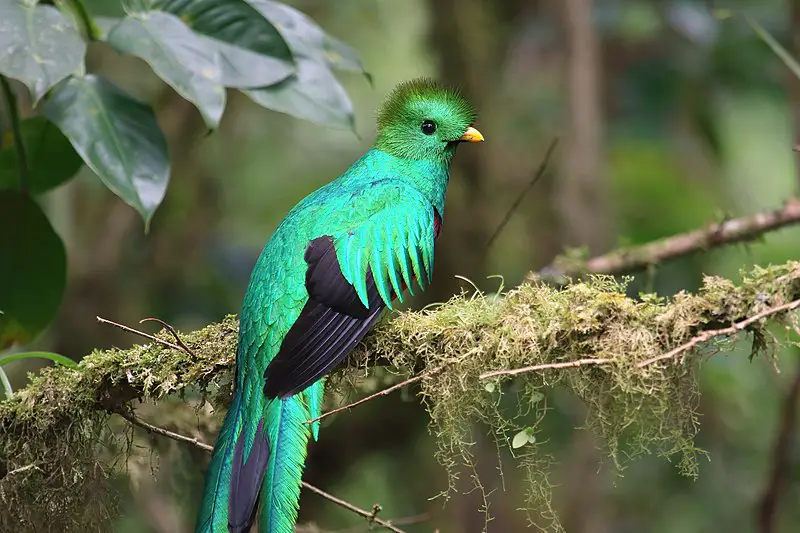
The resplendent quetzal is a beautiful and vibrant bird found in Central America. It belongs to the family Trogonidae, which includes birds like trogons and motmots.
This species of quetzal has two recognized subspecies: P. mocinno and P. costaricensis, both living in tropical forests such as montane cloud forests.
They are omnivores, typically eating fruits from various plants along with insects, lizards or eggs when available.
The male’s plumage is particularly striking with its multi-colored feathers ranging from green to blue to red that gives it its namesake “resplendence” look.
This coloration comes at a price for males because their bright colors make them more visible predators than females who have duller brown coloring instead.
Regardless of gender though all members of this species demonstrate great agility in flight due to their long tails which help stabilize them even through tight turns.Scientific classification:
| Kingdom | Animalia |
| Phylum | Chordata |
| Class | Aves |
| Order | Trogoniformes |
| Family | Trogonidae |
| Genus | Pharomachrus |
| Species | P. mocinno |
Also Featured In: Most Beautiful Birds in Guatemala,
22. Chestnut-Eared Aracari
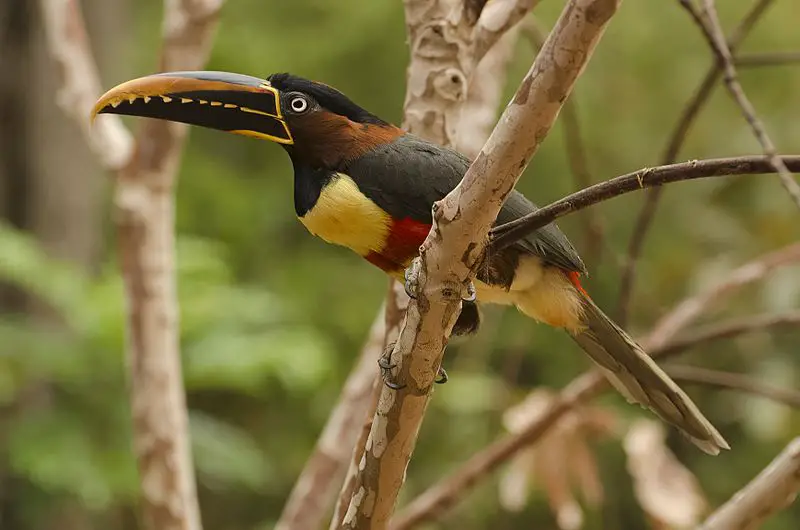
The Chestnut-eared Aracari is a beautiful near-passerine bird found in Argentina, Bolivia, Brazil, Colombia, Ecuador Paraguay and Peru. It has two subspecies – the nominate Pteroglossus castanotis and P.
c australis – both of which have bright chestnut colored feathers at their ears that really stand out against its mostly black body plumage.
The average size for this species is 43 cm (17 inches) long but can reach up to around 48 cm (19 inches).
They are known to be quite vocal birds with loud calls being heard during flight or while they feed on fruits at canopy level as they hop from branch to branch using their strong feet and curved bills.
This stunning creature will always capture attention due to its bold colors making it a real delight for any nature lover.Scientific classification:
| Kingdom | Animalia |
| Phylum | Chordata |
| Class | Aves |
| Order | Piciformes |
| Family | Ramphastidae |
| Genus | Pteroglossus |
| Species | P. castanotis |
Also Featured In: Birds of Bolivia,
23. Lineated Woodpecker

The Lineated Woodpecker is a large bird found in Mexico, Argentina and the Caribbean. It was first described by French zoologist Mathurin Jacques Brisson in 1760 with the name Le pic noir.
This species has black upperparts, wings and tail with white stripes running along its back and head; it also features red marks on its forehead as well as on both sides of its neck.
Its underparts are mostly greyish-white while its bill is yellowish-black and slightly hooked at the end.
These birds feed mainly on insects but can sometimes be seen foraging for fruits or tree sap too.
They nest inside cavities usually made from dead trees which they excavate themselves using their strong bills perfect for drilling into woody material easily.
All in all, these beautiful birds make an interesting addition to any backyard garden.Scientific classification:
| Kingdom | Animalia |
| Phylum | Chordata |
| Class | Aves |
| Order | Piciformes |
| Family | Picidae |
| Genus | Dryocopus |
| Species | D. lineatus |
Also Featured In: Birds that Live in Jalisco Birds,
24. Bananaquit
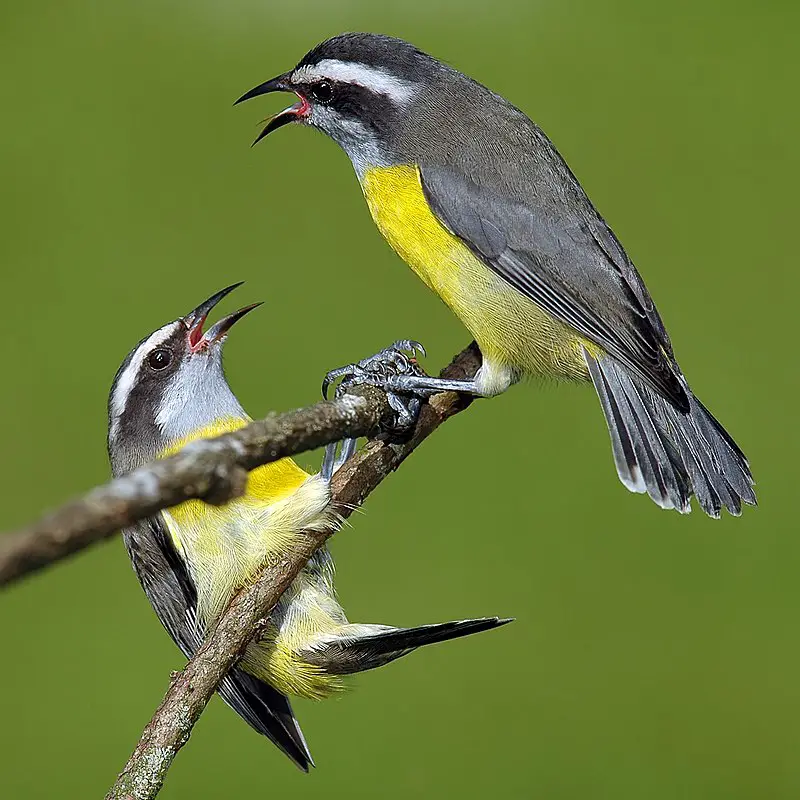
The Bananaquit, scientifically known as Coereba flaveola, is a small passerine bird belonging to the tanager family Thraupidae.
It was previously classified in either its own monotypic family or with other species such as buntings and New World sparrows (Emberizidae) or warblers (Parulidae).
This beautiful little bird has a yellow-green upper body, pale grey head and chestnut brown wings.
Its tail feathers are blackish while its belly is white with some faint streaks of olive green coloration.
The bananaquit can be found across Central America and the Caribbean islands where it feeds on fruits like bananas for which it gets its name from.Scientific classification:
| Kingdom | Animalia |
| Phylum | Chordata |
| Class | Aves |
| Order | Passeriformes |
| Family | Thraupidae |
| Genus | Coereba Vieillot, 1809 |
| Species | C. flaveola |
Also Featured In: Dominican Republic birds, Birds that You’ll Find in Puerto Rico
25. Tropical Kingbird
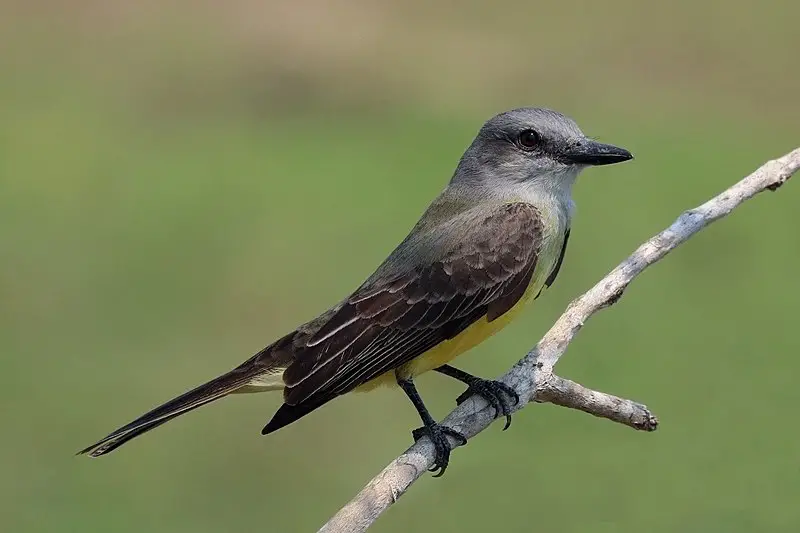
The Tropical Kingbird is an impressive bird, native to the Americas. It’s a large tyrant flycatcher that breeds in southern Arizona and Texas through Central America and down south as far as Argentina and Peru.
This species also lives on Trinidad & Tobago islands. During cold winter months, most of them migrate to warmer climates within its range.
They inhabit open areas such as fields or forests with scattered trees – but away from heavily wooded habitats.
In terms of diet, they mainly feed upon insects which are caught by hawking from perches or snatching up in flight; however it will occasionally eat fruits too.
The adult has grey-brown upperparts, darker wings edged with yellowish feathers plus a white breast band contrasting against pale orange underparts for both sexes.
A conspicuous black mask runs across their eyes completing this beautiful bird’s look.Scientific classification:
| Kingdom | Animalia |
| Phylum | Chordata |
| Class | Aves |
| Order | Passeriformes |
| Family | Tyrannidae |
| Genus | Tyrannus |
| Species | T. melancholicus |
Also Featured In: Most Common Birds In Paraguay, British Columbian Birds
26. Pauraque
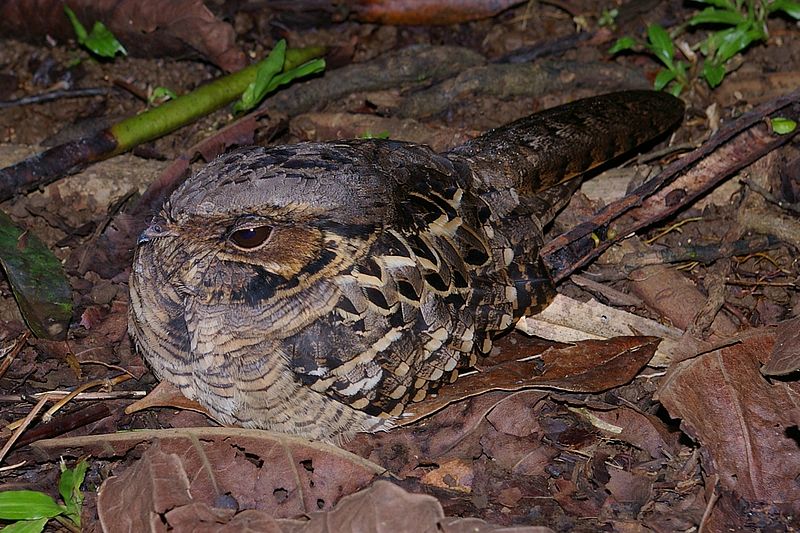
The Pauraque is a nightjar species belonging to the genus Nyctidromus and found in subtropical and tropical regions of the New World. It was formally described by German naturalist Johann in 1789.
Possessing unique features such as distinct white patches on its neck, it has adapted well to living near human settlements; making no noise during day time while roosting among tree branches or low shrubs in open areas with sparse vegetation like pastures, savannahs etc.,
The Pauraque feeds mainly on insects which helps reduce pest populations around agricultural fields.
This bird also plays an important role in maintaining healthy ecosystems across its range due to their habitat preferences for different stages of forest succession, from secondary growth forests to grasslands and scrublands.Scientific classification:
| Kingdom | Animalia |
| Phylum | Chordata |
| Class | Aves |
| Order | Caprimulgiformes |
| Family | Caprimulgidae |
| Genus | Nyctidromus |
| Species | N. albicollis |
Also Featured In: Colorful Birds of Nicaragua, Birds You’ll Find in South Texas
27. Laughing Falcon
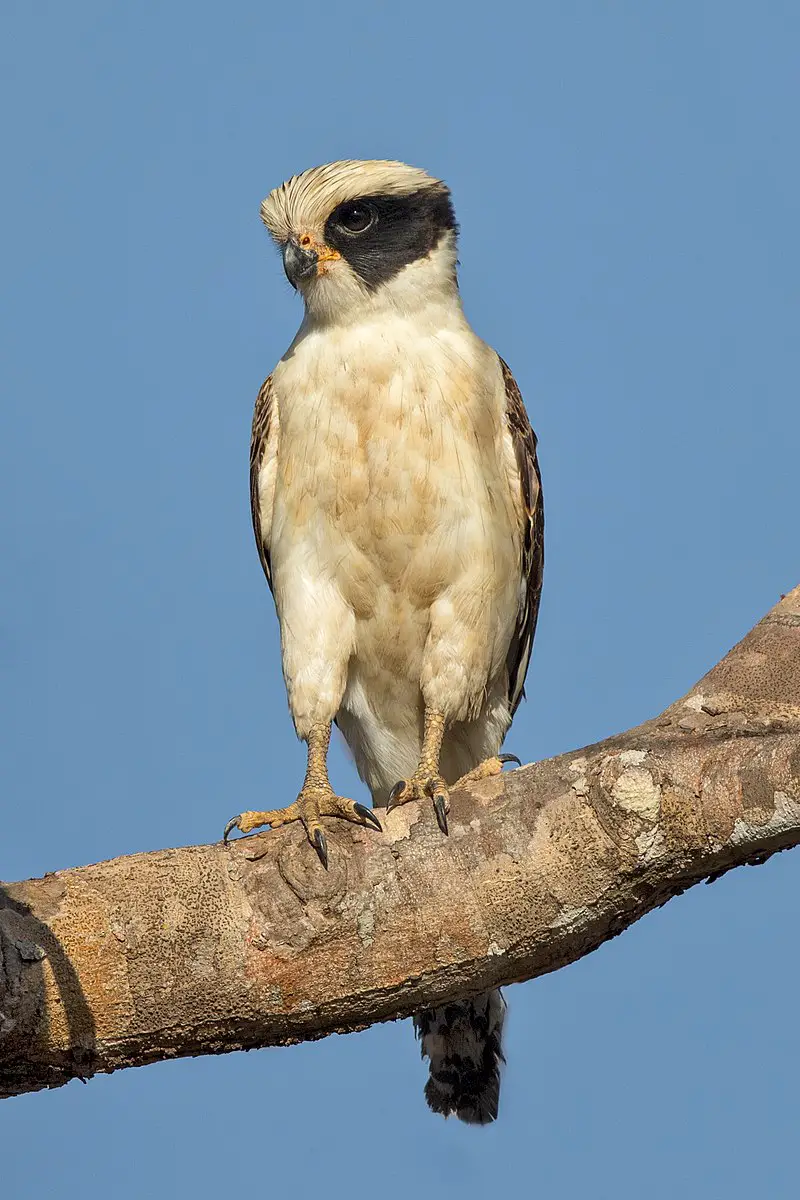
The Laughing Falcon is a medium-sized bird of prey belonging to the falcon family. It’s only member of its genus, Herpetotheres cachinnans, and got its name from it’s distinct loud voice.
This Neotropical species is known for being an expert snake eater. With sharp talons and powerful beak they are well equipped for hunting down snakes and lizards with ease.
Despite their fierce reputation they have a gentle side too; pairs usually mate for life while looking after their offspring together in harmony.
The Laughing Falcon should be admired rather than feared as this amazing creature has much more to offer than just hissing sound effects.Scientific classification:
| Kingdom | Animalia |
| Phylum | Chordata |
| Class | Aves |
| Order | Falconiformes |
| Family | Falconidae |
| Subfamily | Herpetotherinae |
| Genus | Herpetotheres Vieillot, 1817 |
| Species | H. cachinnans |
28. Cotinga
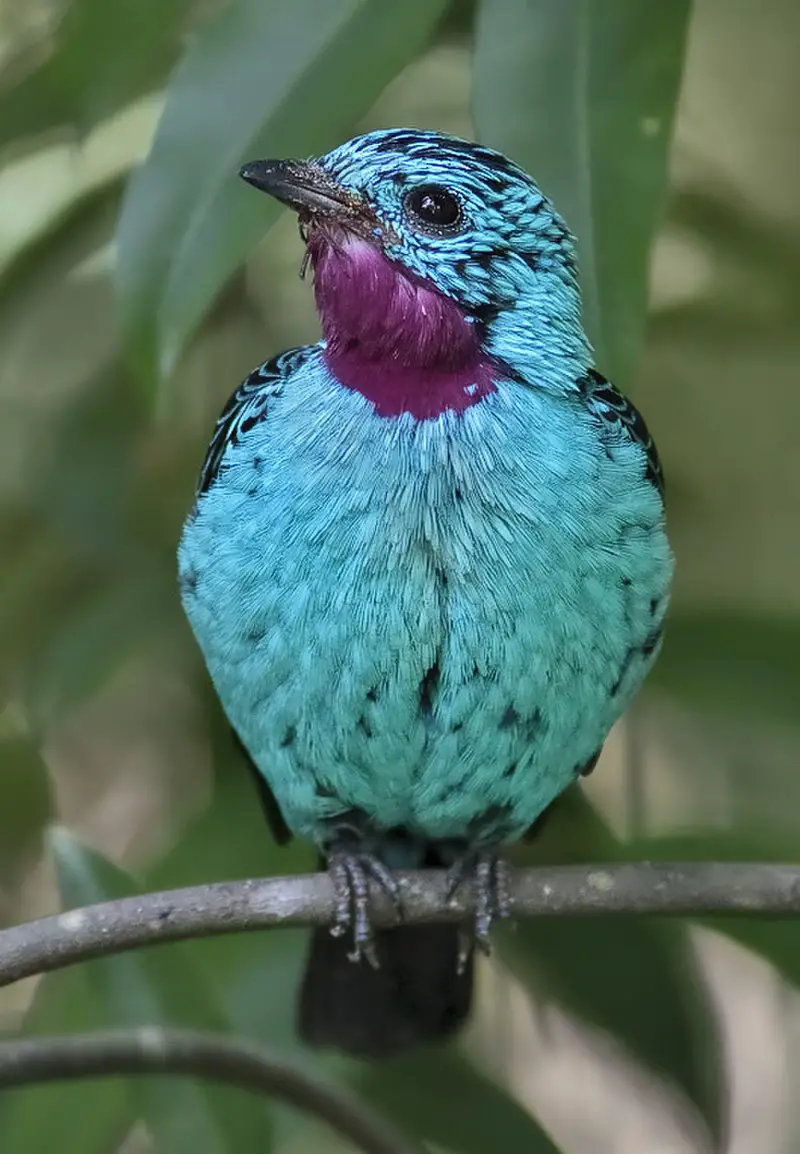
Cotingas are a large family of passerine birds that inhabit Central and South America. They have broad bills with hooked tips, rounded wings, and strong legs.
These colorful birds usually live in forests or forest edges and feed mainly on fruits. Cotinga species range from 12-13 cm (4.7–5.1 inches) to 48-51 cm long depending on the type of bird.
The fiery-throated fruiteater is among the smallest members while others like cocks -of –the rock can reach up to 51cm long.
All these birds display spectacular colors which makes them popular amongst bird watchers all over the world..Scientific classification:
| Kingdom | Animalia |
| Phylum | Chordata |
| Class | Aves |
| Order | Passeriformes |
| Parvorder | Tyrannida |
| Family | Cotingidae Bonaparte, 1849 |
Also Featured In: Costa Rica Birds,
29. Boat-Billed Heron
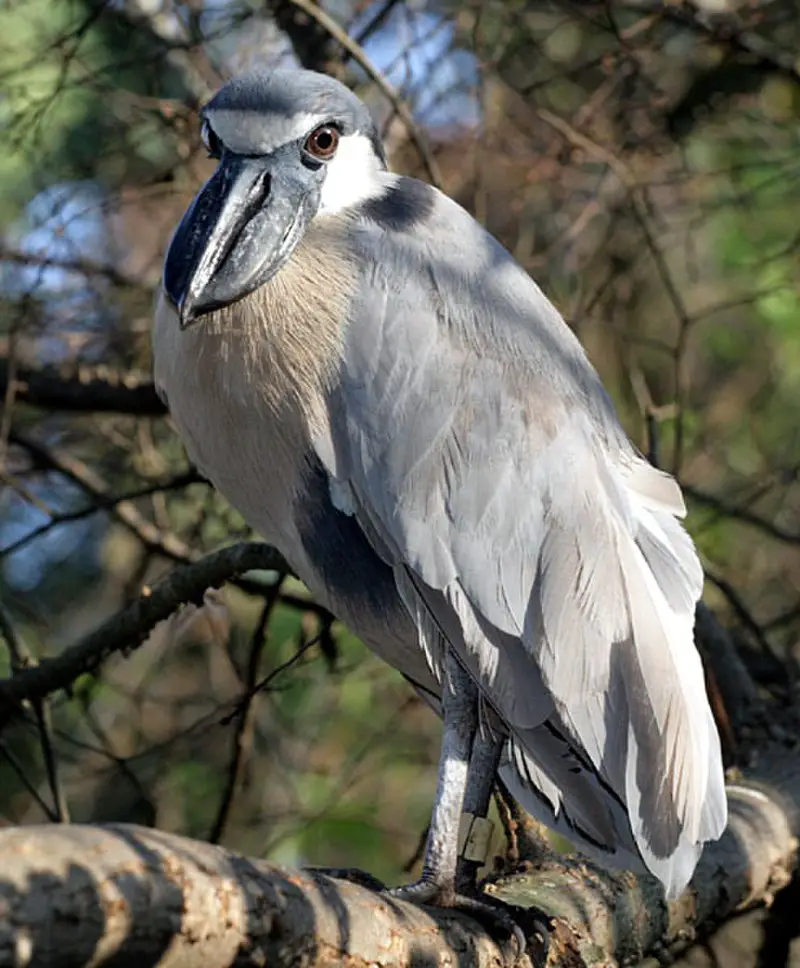
The Boat-billed Heron is a unique member of the heron family, living in mangrove swamps from Mexico to Peru and Brazil. It has an atypical bill shape compared to other members of its family which gives it its name.
Due to its nocturnal behavior, this bird breeds semi-colonially in mangrove trees during the night and lays two to four blue eggs per clutch that take around three weeks for incubation.
This species also exhibits some interesting hunting techniques such as spreading out its wings while standing still on branches or even submerging itself partially into water until prey passes by within reach; so they can snatch them quickly with their long beaks.
Conservation efforts must continue due to threats posed by habitat loss and human disturbance.Scientific classification:
| Kingdom | Animalia |
| Phylum | Chordata |
| Class | Aves |
| Order | Pelecaniformes |
| Family | Ardeidae |
| Subfamily | Tigriornithinae |
| Genus | Cochlearius Brisson, 1760 |
| Species | C. cochlearius |
30. Spectacled Owl
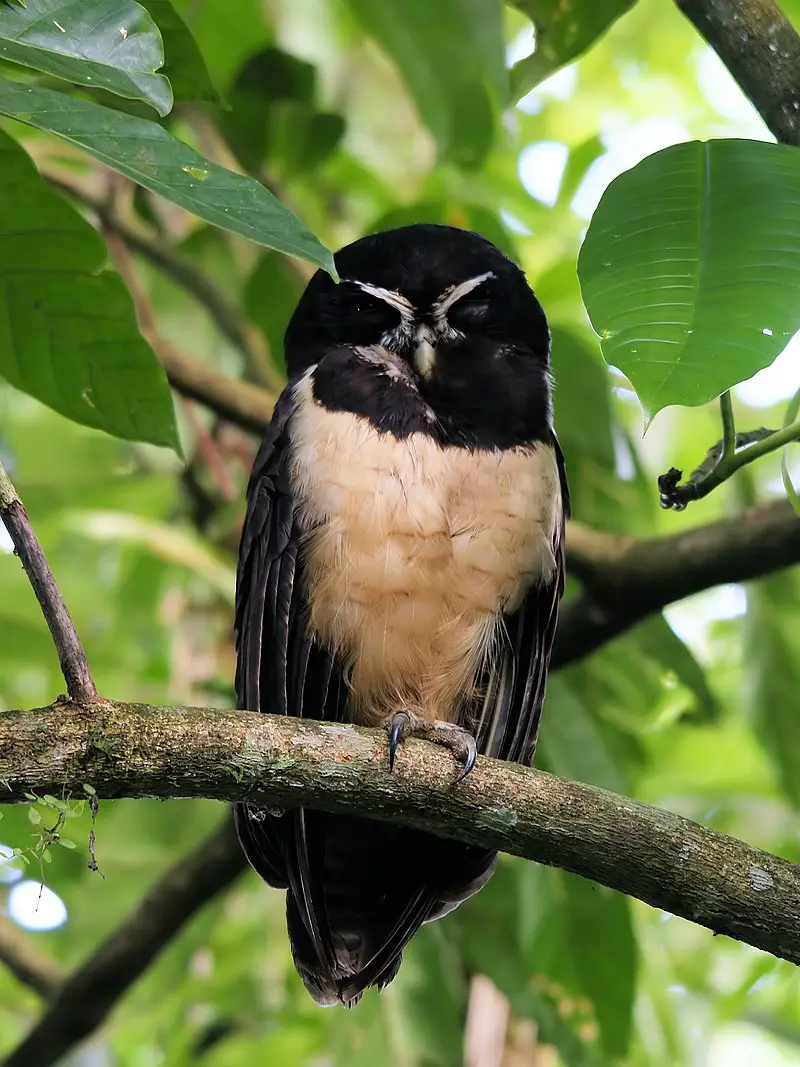
The Spectacled Owl is a large tropical owl that breeds in forests from southern Mexico, Trinidad and Central American countries to Southern Brazil, Paraguay and Argentina.
It has six subspecies with one of them sometimes considered as a separate species called the Short-Browed or Brown Spectacled Owl.
The bird’s body is covered by an array of feathers which are typically dark brown streaked with lighter shades marking its eyes like spectacles; this gives it its name.
Its call could be described as a series of hoots followed by shrieks making it easily distinguishable amongst other owls.
This nocturnal predator feeds mostly on small mammals such as mice while larger prey items include frogs, bats and even birds.Scientific classification:
| Kingdom | Animalia |
| Phylum | Chordata |
| Class | Aves |
| Order | Strigiformes |
| Family | Strigidae |
| Genus | Pulsatrix |
| Species | P. perspicillata |
Also Featured In: Panama Birds,
31. Chestnut-Fronted Macaw
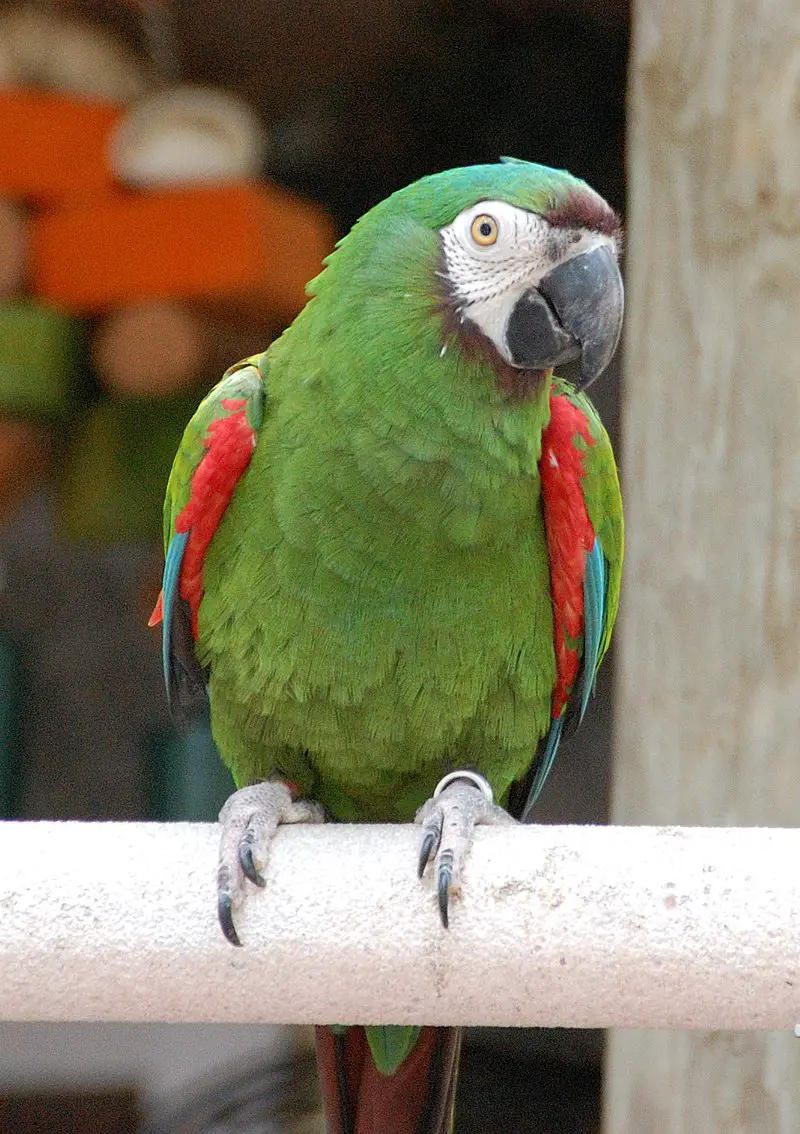
The Chestnut-fronted Macaw, also known as the Severe Macaw, is a mini-macaw species native to Northern South America.
They are considered one of the largest macaws and typically reach 18 inches in length with half of that being from their tail.
These beautiful birds can be found stretching from Panama down into Brazil and Bolivia while they have even established a feral population in Florida.
With an expected lifespan ranging anywhere between 30 to 50 years these exotic beauties make for quite endearing companions if properly taken care of.
For those looking for interesting conversation pieces or feathered friends this may just be your perfect choice.Scientific classification:
| Kingdom | Animalia |
| Phylum | Chordata |
| Class | Aves |
| Order | Psittaciformes |
| Family | Psittacidae |
| Genus | Ara |
| Species | A. severus |
Also Featured In: Green Birds Commonly Found in Florida,
32. Common Potoo
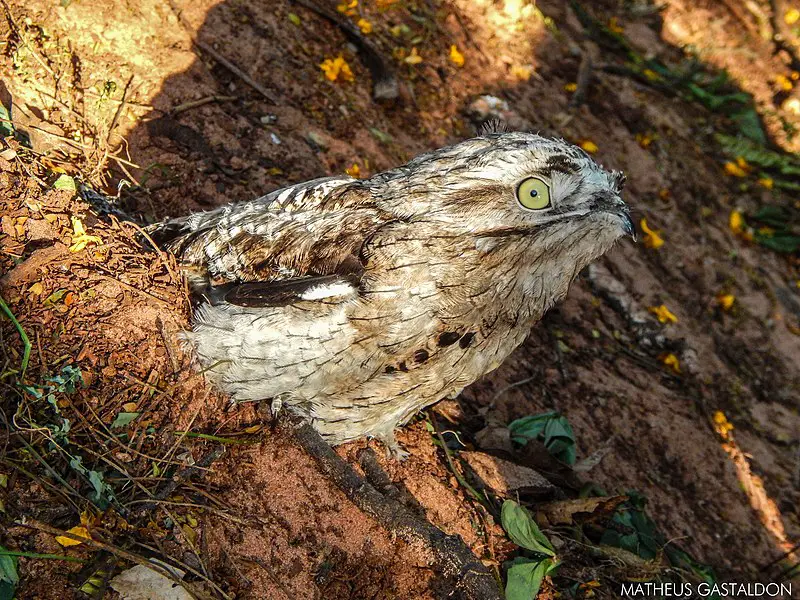
The Common Potoo is an intriguing species of bird, belonging to the Nyctibius genus and related to nightjars and frogmouths. It has large yellow eyes that stand out in its wide open mouth, giving it a comical look.
This nocturnal creature lives mainly in Central America but can also be found as far south as Argentina.
Its feathers are typically dark brown or grey with white markings on its neck and wings providing camouflage during the day when they roost motionless amongst tree branches.
The call of this mysterious bird is described as a loud whistle which rises from low-pitched “poor me” notes towards higher pitched ones at dawn and dusk – hence why it’s commonly known as ‘Poor Me Ones’.Scientific classification:
| Kingdom | Animalia |
| Phylum | Chordata |
| Class | Aves |
| Order | Nyctibiiformes |
| Family | Nyctibiidae |
| Genus | Nyctibius |
| Species | N. griseus |
33. Orange-Winged Amazon
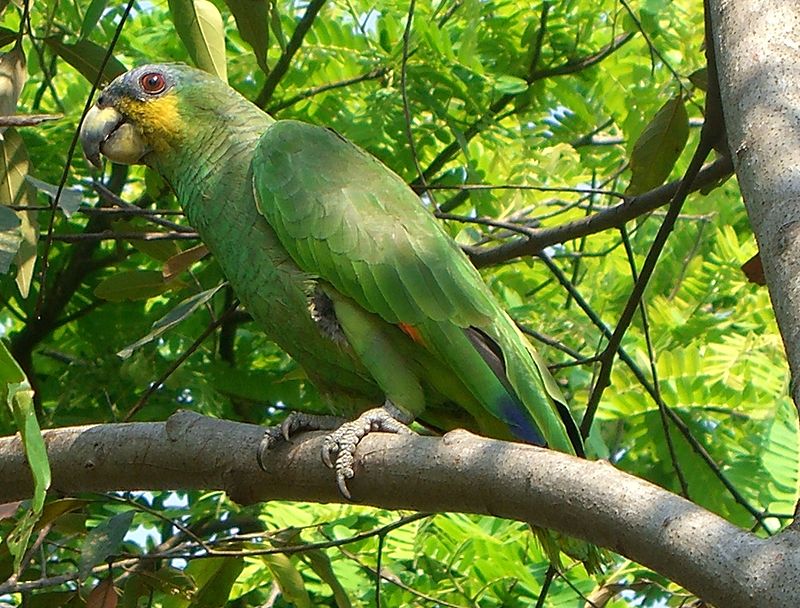
The orange-winged amazon is a vibrant and large parrot native to South America. Its habitat consists of both tropical forests and semi-open country areas, spanning from Colombia, Trinidad & Tobago down to Peru, Bolivia and central Brazil.
Although its population seems healthy at the moment due to its wide range throughout these countries, it still suffers persecution as an agricultural pest as well as capture for the pet trade industry.
It has striking features that make it easily distinguishable; namely bright red feathers on its forehead along with yellowish-orange wings which give this bird its name.
With proper protection against poaching and hunting by humans in place they should remain a colorful addition to our planet’s avian family.Scientific classification:
| Kingdom | Animalia |
| Phylum | Chordata |
| Class | Aves |
| Order | Psittaciformes |
| Family | Psittacidae |
| Genus | Amazona |
| Species | A. amazonica |
Also Featured In: Trinidad and Tobago birds,
34. Agami Heron
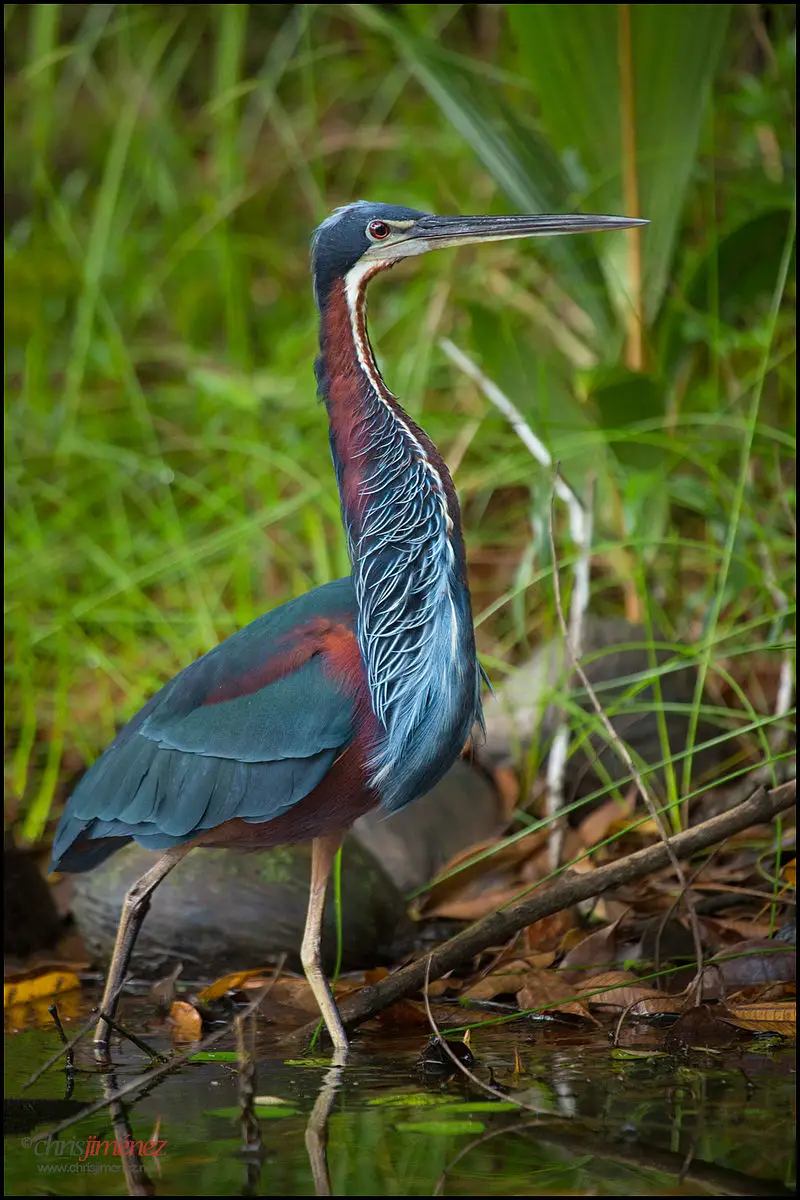
The Agami Heron is a medium-sized heron with unique features. It can be found in Central America all the way to Peru and Brazil, where it is sometimes referred to as Soco Beija-Flor or ‘Hummingbird Heron’ due to its colorful appearance.
This species of bird has been classified as vulnerable by The IUCN Red List of Threatened Species mainly because of the destruction of its wetland habitats from human activity such as agriculture, pollution and overfishing.
As a result, conservation efforts are being taken worldwide for this beautiful creature so that future generations will have an opportunity to enjoy their presence in our environment.
With proper management we can ensure that these birds remain safe and plentiful into the future.Scientific classification:
| Kingdom | Animalia |
| Phylum | Chordata |
| Class | Aves |
| Order | Pelecaniformes |
| Family | Ardeidae |
| Subfamily | Ardeinae |
| Genus | Agamia Reichenbach, 1853 |
| Species | A. agami |
35. Cocoi Heron
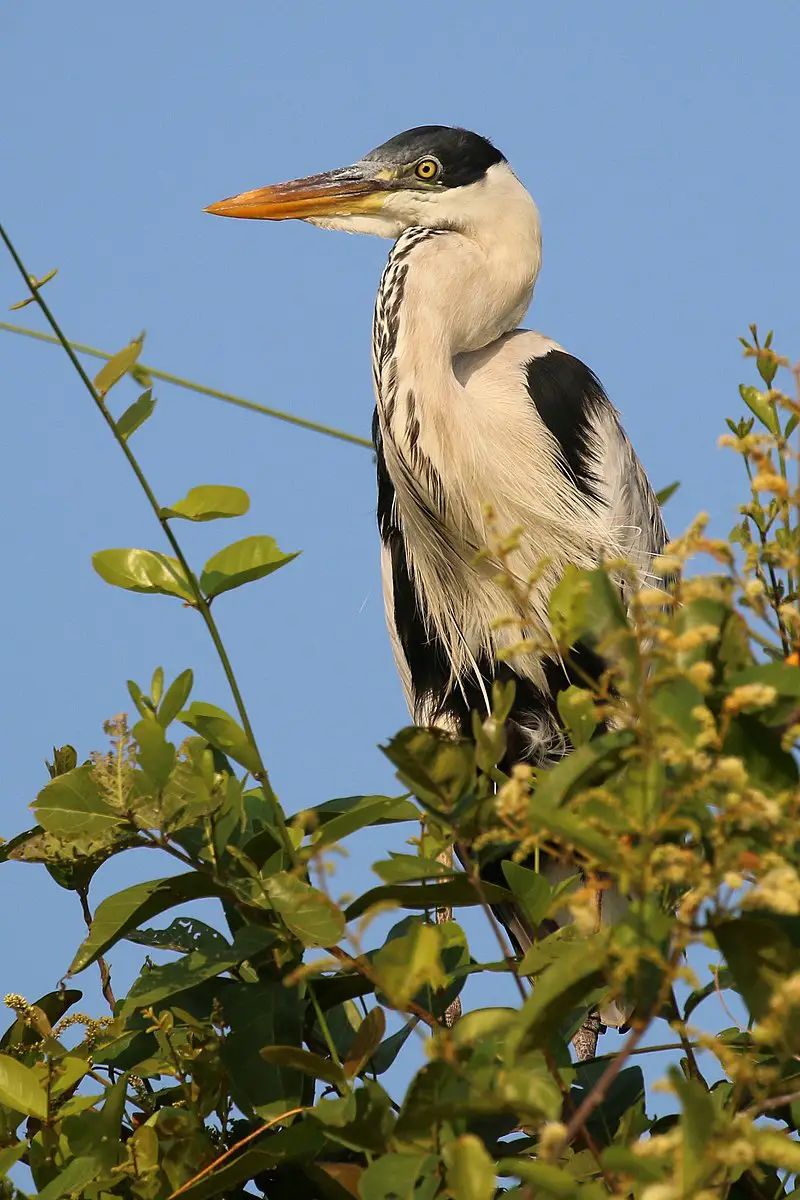
The Cocoi Heron is a majestic wading bird found in South America. It has a distinctive pale grey plumage and darker grey crest, making it easily recognizable among other herons.
This carnivore hunts for fish and crustaceans in shallow water with its long legs, giving the appearance of gracefulness even while feeding.
The origin of this species’ name remains unknown despite being first described by Carl Linnaeus back in 1766 as part of his 12th edition Systema Naturae publication.
The Cocoi Heron continues to captivate onlookers today due to its elegant beauty and remarkable hunting skills.Scientific classification:
| Kingdom | Animalia |
| Phylum | Chordata |
| Class | Aves |
| Order | Pelecaniformes |
| Family | Ardeidae |
| Genus | Ardea |
| Species | A. cocoi |
Also Featured In: Guyana birds,
36. Greater Yellow-Headed Vulture
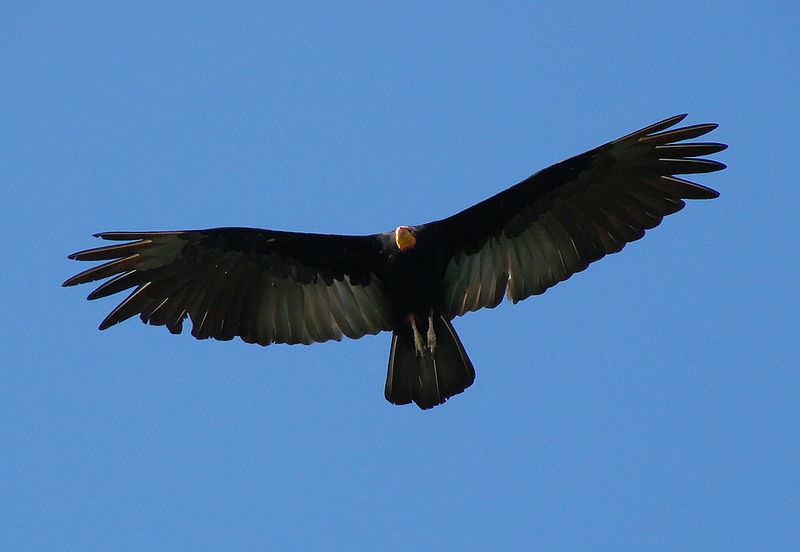
The Greater yellow-headed vulture is a species of bird belonging to the New World Vulture family. It has a wingspan ranging from 166-178 cm and can be found in tropical moist lowland forests located in South America.
This bird is an excellent scavenger, as it mainly feeds on carrion and sometimes eggs or nestlings of other birds.
They are also known for their loud calls that act as signals between different individuals within the same group.
The population size of the greater yellow-headed vulture remains stable globally, however there are certain areas where its numbers have decreased due to threats such deforestation and hunting by humans.
Conservation efforts should thus focus on preserving suitable habitats so these majestic birds can continue to thrive.Scientific classification:
| Kingdom | Animalia |
| Phylum | Chordata |
| Class | Aves |
| Order | Accipitriformes |
| Family | Cathartidae |
| Genus | Cathartes |
| Species | C. melambrotus |
Also Featured In: Suriname birds,
37. Sun Conure
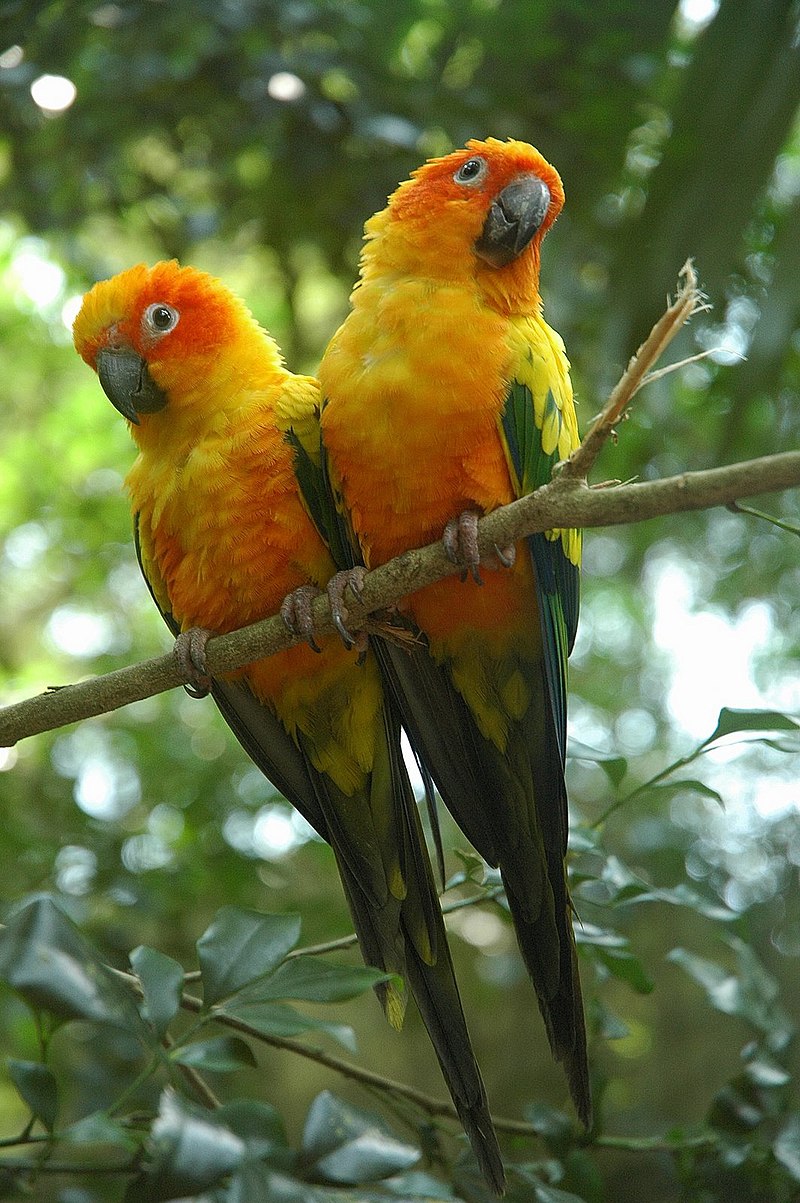
The Sun Conure is a vibrant and social species of parrot native to northeastern South America. Both males and females have predominantly golden-yellow plumage, with orange flushes under the face and wings tipped in green and blue.
They are medium sized birds with black beaks that can make for great companions when properly cared for.
These birds love attention from their owners, so it’s important to spend quality time interacting with them on a regular basis to ensure they remain happy and healthy.
As conures go, the Sun Conure stands out due its bright colours which makes them popular among bird lovers around the world.Scientific classification:
| Kingdom | Animalia |
| Phylum | Chordata |
| Class | Aves |
| Order | Psittaciformes |
| Family | Psittacidae |
| Genus | Aratinga |
| Species | A. solstitialis |
Also Featured In: Parrots Species, Aviary Birds You Should Know
38. Southern Mealy Amazon
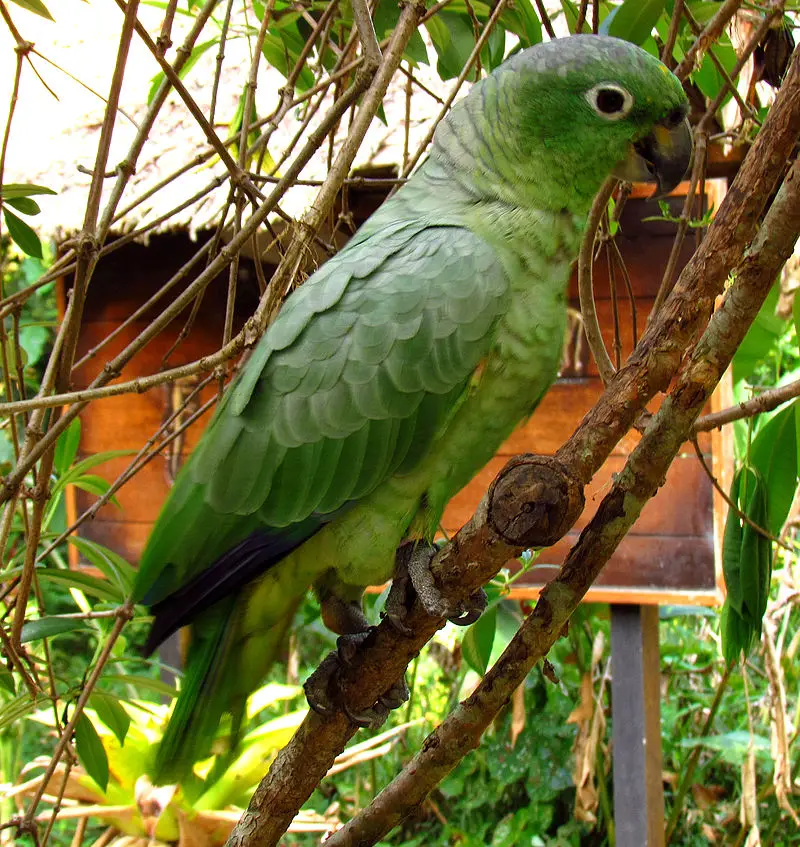
The Southern mealy Amazon is a large and vibrant parrot native to Central and South America. It has an impressive total length of between 38-41 cm, with its body being mainly green in colour.
The species was formerly considered conspecific with the Northern Mealy Amazon, although they are now recognized as separate species by some taxonomic authorities.
This bird loves to feed on fruits and seeds found in the wild but can also be kept as pets if taken care of properly.
Its diet should include plenty of fresh fruit such as apples, oranges or bananas along with other nutritious foods like nuts or grains for balanced nutrition.
Despite their size, these birds form strong bonds with their owners when given enough attention.Scientific classification:
| Kingdom | Animalia |
| Phylum | Chordata |
| Class | Aves |
| Order | Psittaciformes |
| Family | Psittacidae |
| Genus | Amazona |
| Species | A. farinosa |
39. Green Honeycreeper
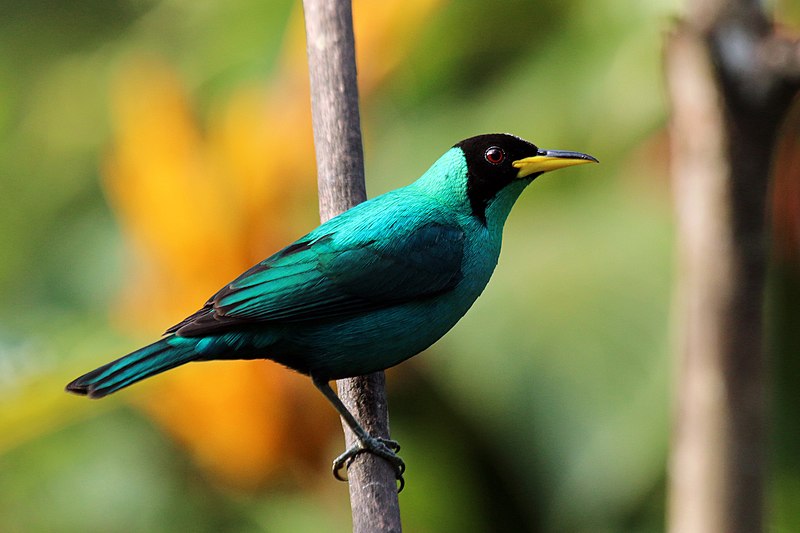
The Green Honeycreeper is a vibrant and colorful bird of the tanager family. It can be found in tropical parts of Mexico, Central America and South America up to Brazil.
This species was first formally described by Swedish naturalist Carl Linnaeus in 1758 under its current name Mota.
The bright green plumage gives it an attractive look making them popular among ornithologists and nature lovers alike.
They mainly feed on nectar from flowers as well as small insects which they catch while flying or hopping around trees and shrubs near forest edges.
These birds are known for their melodious songs often heard during mating season when males sing to attract females – a trait that helps make these birds so captivating.Scientific classification:
| Kingdom | Animalia |
| Phylum | Chordata |
| Class | Aves |
| Order | Passeriformes |
| Family | Thraupidae |
| Genus | Chlorophanes Reichenbach, 1853 |
| Species | C. spiza |
Also Featured In: birds of green birds, Common Tropical Rainforest Birds
40. Fork-Tailed Woodnymph
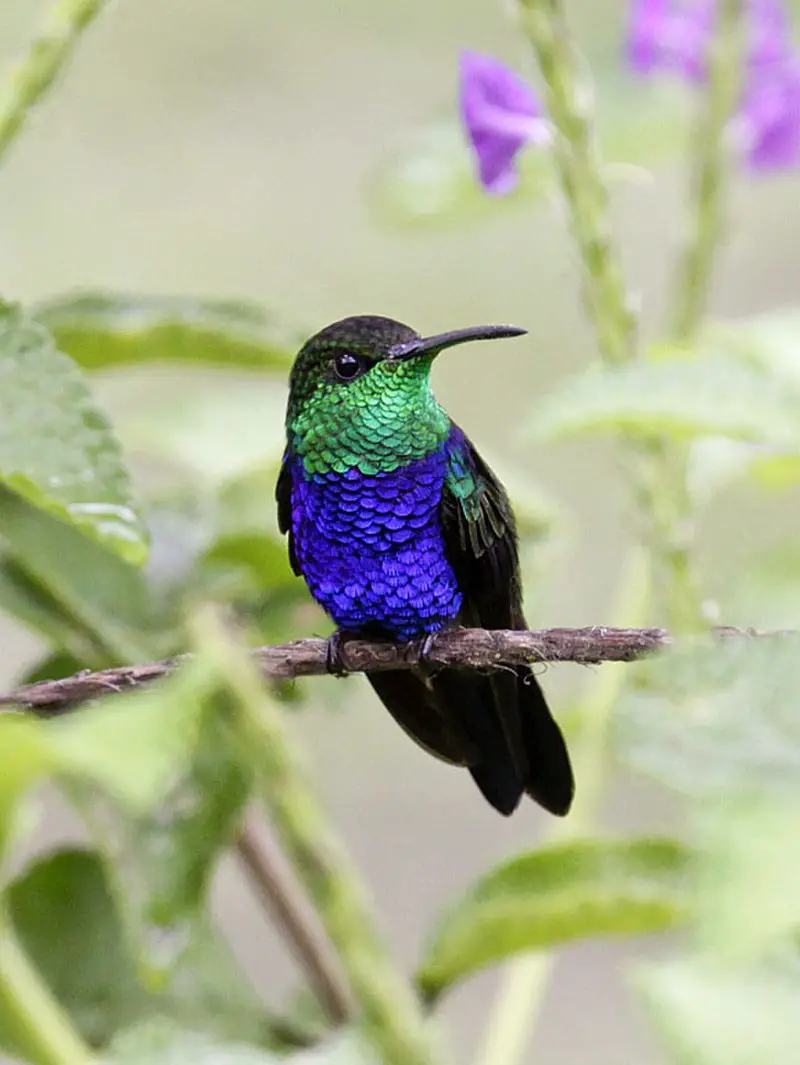
The Fork-tailed Woodnymph is a species of hummingbird belonging to the Trochilini tribe. It can be found in all mainland South American countries except Chile and Uruguay.
This bird was formally described by German naturalist Johann Friedrich Gmelin back in 1788 when he revised an expanded edition of Carl Linnaeus’s Systema Naturae.
They have vibrant green feathers, with black upperparts, tail tips and throat patch which gives them their signature look.
The most eye catching feature however are their long forked tails that they use as part of courtship displays or simply to streamline during flight.
These birds also feed on flower nectar throughout the day, making them some of nature’s hardest workers.Scientific classification:
| Kingdom | Animalia |
| Phylum | Chordata |
| Class | Aves |
| Order | Apodiformes |
| Family | Trochilidae |
| Genus | Thalurania |
| Species | T. furcata |
Also Featured In: birds of purple,
41. Oropendola
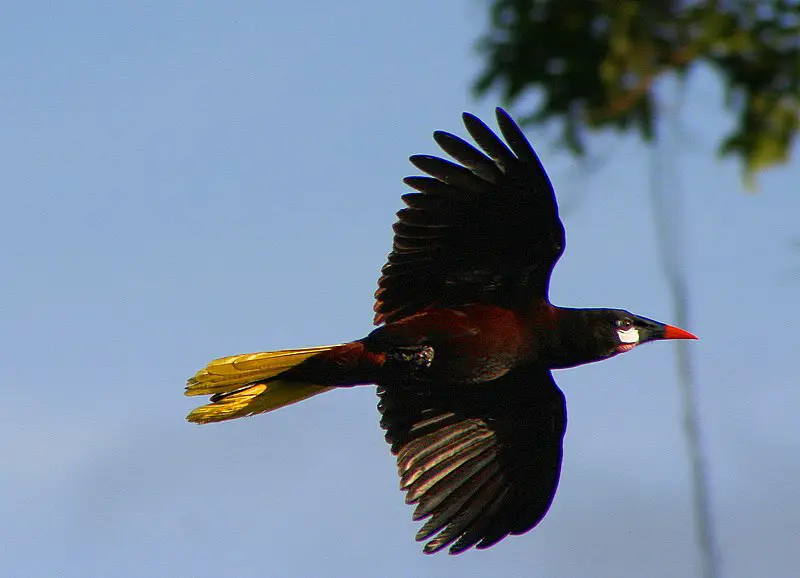
Oropendola birds belong to the Psarocolius genus and are part of the Icteridae family of New World blackbirds. These birds are found in Central and South America.
Their plumage is chestnut with long tails that are partially bright yellow, and they have pointed bills.
Males are usually larger than females. These birds are known for their size and distinctive appearance.
They were once split into different genera, but they are currently classified under Psarocolius.
With their long tails and pointed bills, Oropendola birds are truly unique and fascinating to witness in their natural habitat.Scientific classification:
| Kingdom | Animalia |
| Phylum | Chordata |
| Class | Aves |
| Order | Passeriformes |
| Family | Icteridae |
| Genus | Psarocolius Wagler, 1827 |
Also Featured In: Birds That Live in the Jungle,
42. True Macaws

True macaws are a diverse group of parrots belonging to the genus Ara. These colorful birds are found in the Neotropics and are known for their large size and striking plumage.
There are eight extant species of True macaws, each with their own unique colors and patterns.
The genus name Ara was coined in 1799 by French naturalist Bernard Germain de Lacépède and is derived from the Tupi word ará, which is the onomatopoeia for the sound a macaw makes.
True macaws are part of the Arini tribe of neotropical parrots and are highly prized in the pet trade for their beauty and intelligence.
However, many True macaw species are also endangered due to habitat loss and poaching, making conservation efforts crucial for their survival.Scientific classification:
| Kingdom | Animalia |
| Phylum | Chordata |
| Class | Aves |
| Order | Psittaciformes |
| Family | Psittacidae |
| Tribe | Arini |
| Genus | Ara Lacépède, 1799 |
43. Cassowaries
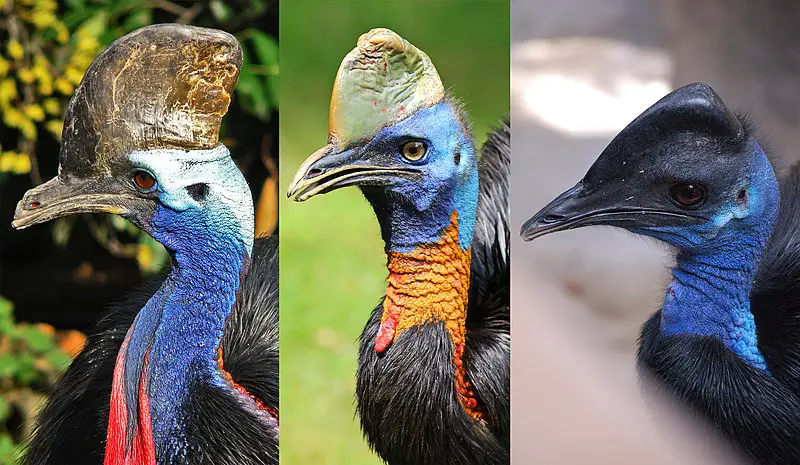
Cassowaries are unique, flightless birds belonging to the genus Casuarius. They are classified as ratites, and they do not have a keel on their sternum bones.
These fascinating birds are found in the tropical forests of New Guinea, Aru Islands, and northeastern Australia. Three species of cassowaries still exist, with the most prevalent being the Southern cassowary.
They are known for their crest, which protrudes from their heads, and their bright blue skin on their neck and head.
Cassowaries are also known for their sharp talons that can grow up to 12 centimeters long, and they can jump up to 1.5 meters high.
Cassowaries are often described as being dangerous as they have been known to attack humans when provoked, but they also play a vital role in their ecosystem as seed dispersers.Scientific classification:
| Kingdom | Animalia |
| Phylum | Chordata |
| Class | Aves |
| Infraclass | Palaeognathae |
| Order | Casuariiformes |
| Family | Casuariidae Kaup, 1847[1] |
| Genus | Casuarius Brisson, 1760 |
Also Featured In: Birds You’ll Find in Zoo, Most Common Nature Birds
44. Cock-Of-The-Rock
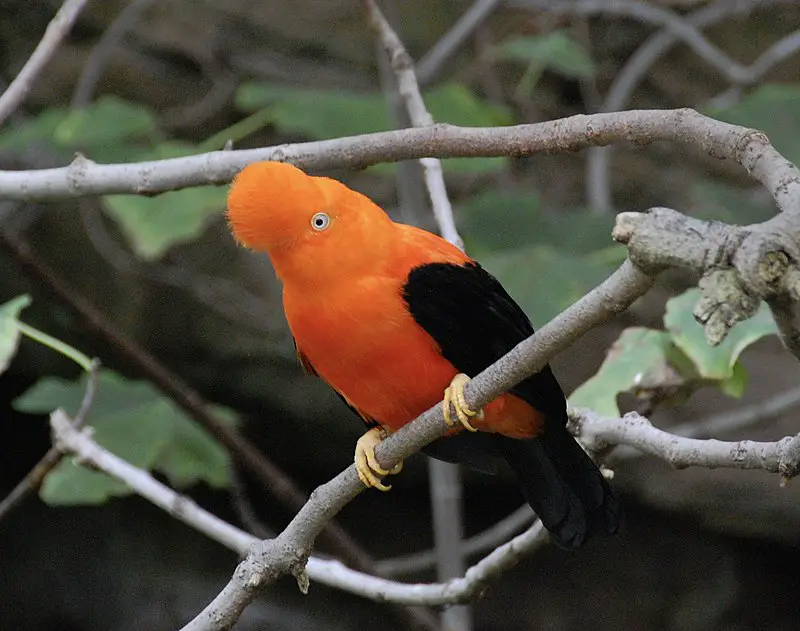
Cock-of-the-rock birds belong to the Rupicola genus and are found in South America. They are large and are part of the cotingid family. These birds usually live in rainforests and are generally found close to rocky areas.
This is also where they build their nests. The species were first documented in the mid-1700s during a research expedition.
The Cock-of-the-rock is known for its unique appearance, with males having bright orange heads and chests.
They are popular among bird watchers and are often featured in nature documentaries. Due to habitat loss and hunting, the population of these birds is decreasing.
Conservation efforts are being made to protect them and their natural habitat.Scientific classification:
| Kingdom | Animalia |
| Phylum | Chordata |
| Class | Aves |
| Order | Passeriformes |
| Family | Cotingidae |
| Genus | Rupicola Brisson, 1760 |
45. Violetear
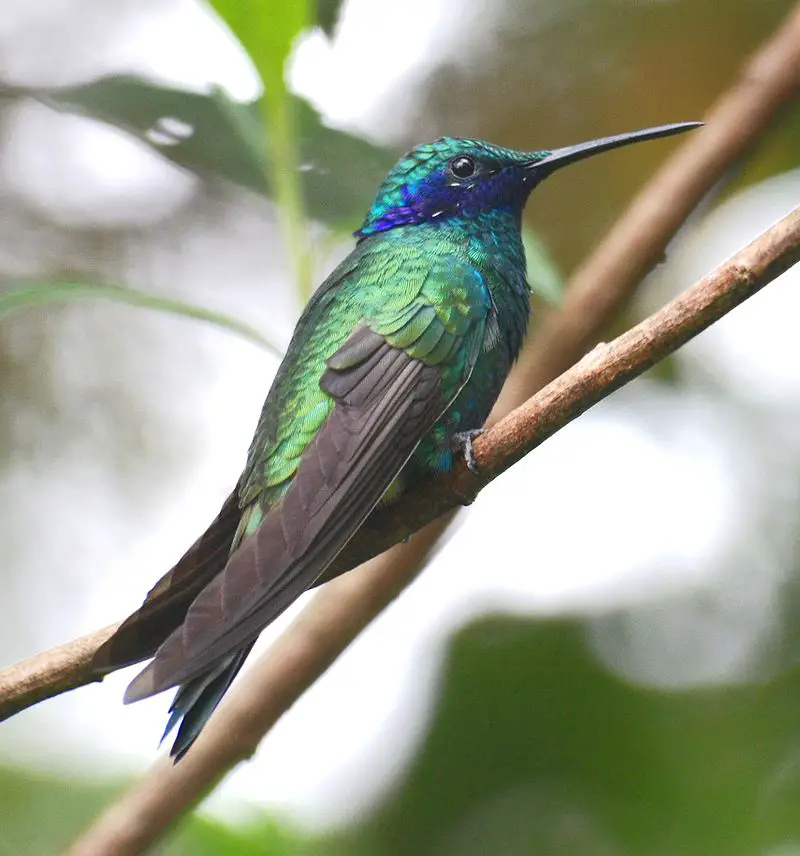
Violetears are a group of hummingbirds found in Mexico, Central and northern South America. They are medium to large-sized birds with rounded tails and short or medium black bills.
Most species have predominantly green plumage, but the males have a violet-blue patch on their throats.
The Mexican violetear sometimes migrates to the United States and Canada. These birds are known for their hovering and darting flight patterns, and their ability to beat their wings up to 80 times per second.
They mainly feed on nectar from flowers, but will also catch insects in flight as a protein source.
Violetears play an important role in pollination and are a cherished sight for birdwatchers in their natural habitats.Scientific classification:
| Kingdom | Animalia |
| Phylum | Chordata |
| Class | Aves |
| Clade | Strisores |
| Order | Apodiformes |
| Family | Trochilidae |
| Subfamily | Polytminae |
| Genus | Colibri Spix, 1824 |
46. Crimson Topaz
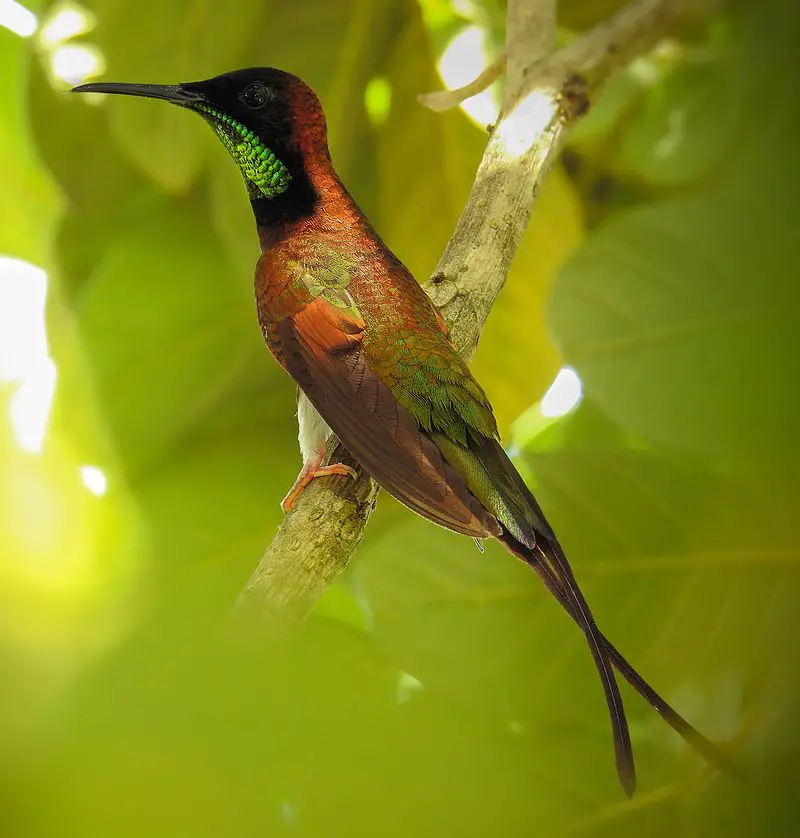
The Crimson Topaz bird, scientifically known as Topaza pella, is a beautiful species of hummingbird found in the tropical regions of Brazil, French Guiana, Guyana, Suriname, and Venezuela.
This bird was first identified and classified by the famous Swedish naturalist, Carl Linnaeus in 1758.
The Crimson Topaz is known for its vibrant red plumage, long tail feathers, and ability to hover in mid-air whilst feeding on nectar from flowers.
It is a popular species amongst birdwatchers and photographers due to its bright, eye-catching appearance.
Despite its small size, the Crimson Topaz plays an important role in pollinating flowers and sustaining the biodiversity in its native habitats.
It is truly a spectacular bird to observe in flight amidst the lush, tropical landscape.Scientific classification:
| Kingdom | Animalia |
| Phylum | Chordata |
| Class | Aves |
| Clade | Strisores |
| Order | Apodiformes |
| Family | Trochilidae |
| Genus | Topaza |
| Species | T. pella |
47. Curl-Crested Aracari
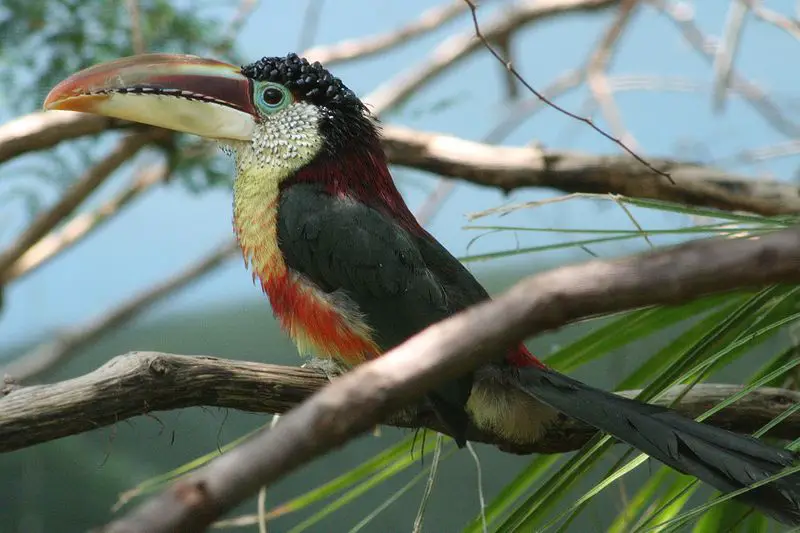
The Curl-crested aracari is a bird species belonging to the toucan family found in Peru, Bolivia and Brazil. Johann Georg Wagler first described it in 1831.
It had been incorrectly named for many years, and the correct name was only established in 2020. The bird is also known as the Curl-crested Araçari and is considered a near-passerine species.
It has been placed in the monotypic genera Beauhar in the past. The bird’s distinctive feature is its curled crest, which gives it a unique appearance.Scientific classification:
| Kingdom | Animalia |
| Phylum | Chordata |
| Class | Aves |
| Order | Piciformes |
| Family | Ramphastidae |
| Genus | Pteroglossus |
| Species | P. beauharnaisii |
48. Collared Aracari
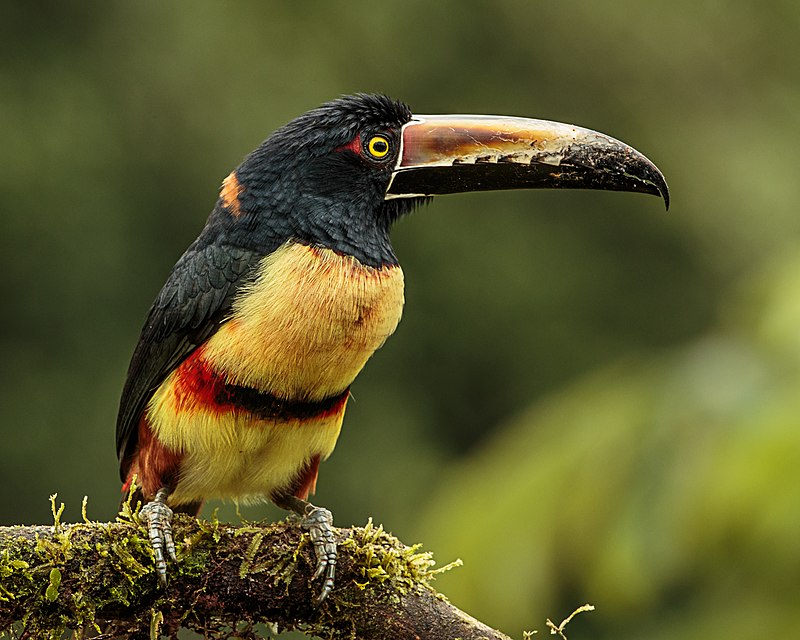
The Collared Aracari, from the toucan family, can be found in various countries from Mexico to Venezuela. Described by the Spanish naturalist Francisco Hernández in the 16th century, this beautiful bird has a colorful collar around its neck.
Unlike other toucans, Collared Aracaris don’t have a large bill, and their diet consists of a mix of fruits, insects, and small animals.
They are social creatures and can be seen in pairs or small groups during the day. These birds make their homes in tree cavities and use their beaks to create a small entrance hole.
They are not considered endangered, but their habitats are under threat due to deforestation. The Collard Aracari is an essential part of the forest ecosystem and deserves our protection.Scientific classification:
| Kingdom | Animalia |
| Phylum | Chordata |
| Class | Aves |
| Order | Piciformes |
| Family | Ramphastidae |
| Genus | Pteroglossus |
| Species | P. torquatus |
Also Featured In: Birds that You’ll Find in Chiapas,
49. Spix’s Guan
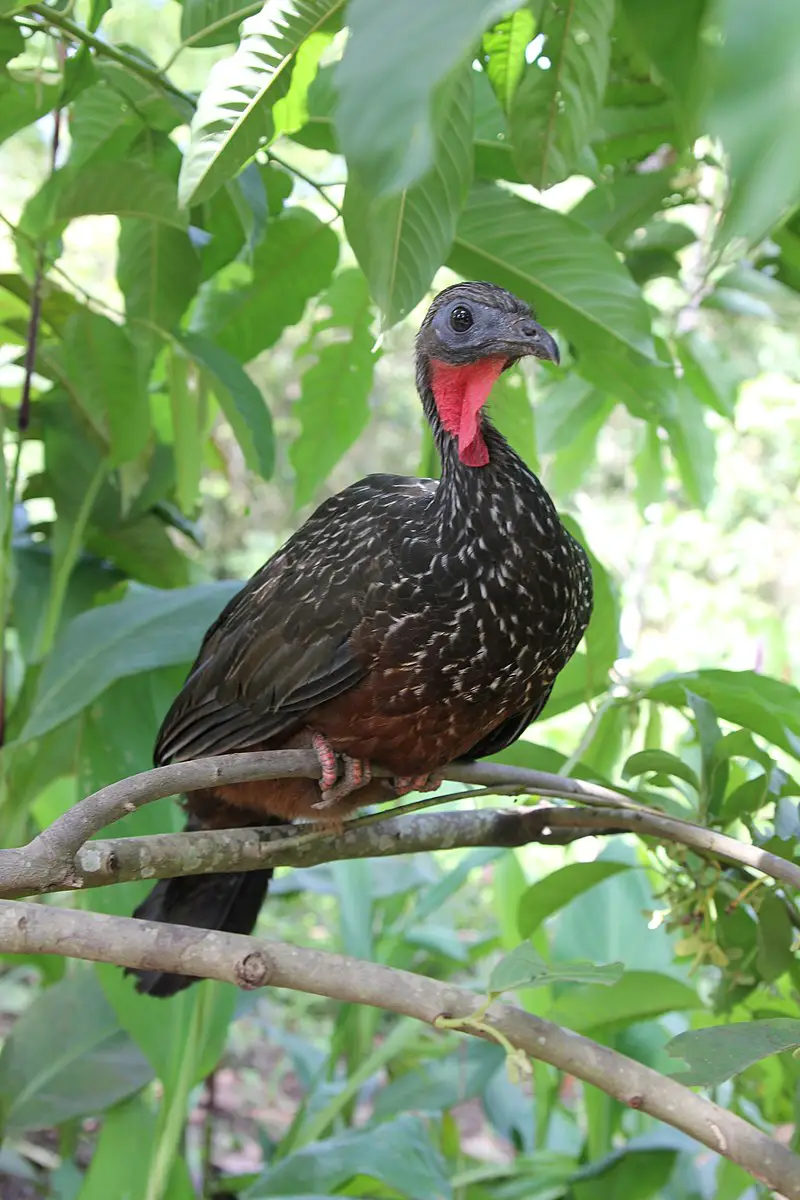
Spix’s guan is a type of bird belonging to the Cracidae family. It is commonly found in the Amazonian lowlands and has four different subspecies, namely “Grant’s” guan and the “Spix’s guan” group.
The bird is named after the German naturalist Johann Baptist von Spix. The Spix’s guan is known for being the standard representative of the cracid species found in the Amazonian lowlands.
It has distinct features and a unique appearance that sets it apart from other birds in the region.
The species is well studied and has been observed and documented by various experts in the field of ornithology.
Overall, Spix’s guan is an interesting and notable bird species found in the Amazonian region.Scientific classification:
| Kingdom | Animalia |
| Phylum | Chordata |
| Class | Aves |
| Order | Galliformes |
| Family | Cracidae |
| Genus | Penelope |
| Species | P. jacquacu |
50. Spotted Catbird

The Spotted catbird is a bird that belongs to the bowerbird family. It can be found in the eastern Moluccas, north Queensland, and New Guinea. Unlike most bowerbirds, it does not create a bower to attract mates.
The Spotted catbird is a commonly seen bird throughout its large range, and as a result, it is listed as a species of “Least Concern” on the IUCN Red List of Threatened Species. This bird has a distinctive spotted appearance, which contributes to its name.
They are opportunistic feeders and eat various fruits, insects, and small reptiles. Their habitat includes rainforests and areas with tall grasses. Their population numbers are steady, and they face no major threats.Scientific classification:
| Kingdom | Animalia |
| Phylum | Chordata |
| Class | Aves |
| Order | Passeriformes |
| Family | Ptilonorhynchidae |
| Genus | Ailuroedus |
| Species | A. maculosus |
Also Featured In: Birds Typically Found in Australian Rainforest, Birds of Far North Queensland
51. Scale-Crested Pygmy Tyrant

The Scale-crested pygmy tyrant, a bird belonging to the family Tyrannidae, boasts a unique crown-like ring of feathers on its head. This feature is used both to attract mates and to appear larger when threatened.
Its habitat ranges from Colombia to Panama and Peru, with possibilities in Ecuador and Honduras. This bird can be found in subtropical and tropical climates.Scientific classification:
| Kingdom | Animalia |
| Phylum | Chordata |
| Class | Aves |
| Order | Passeriformes |
| Family | Tyrannidae |
| Genus | Lophotriccus |
| Species | L. pileatus |